SITHCCC008 Prepare vegetable, fruit, eggs and farinaceous dishes
VerifiedAdded on 2021/09/30
|18
|7307
|430
AI Summary
Contribute Materials
Your contribution can guide someone’s learning journey. Share your
documents today.
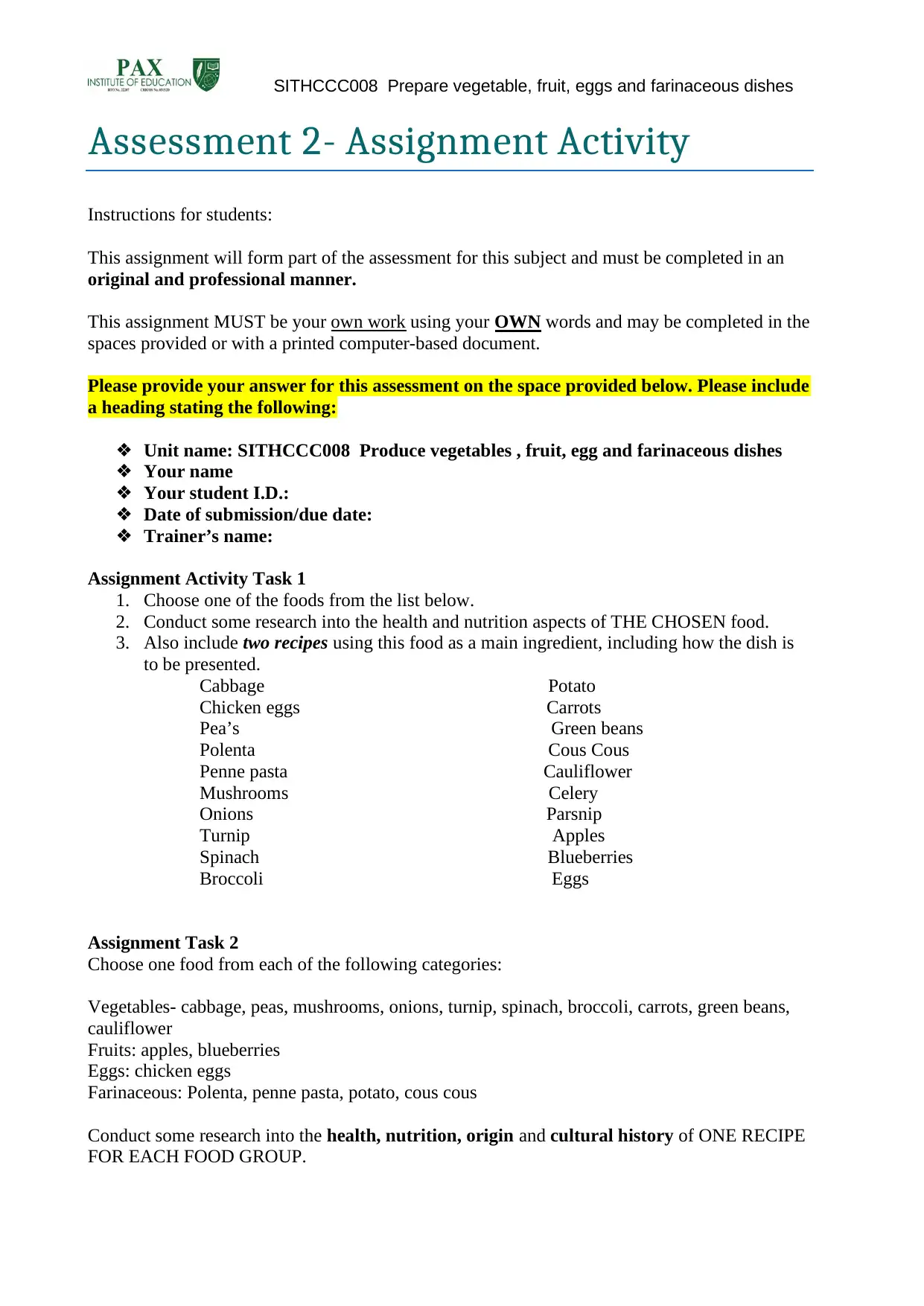
SITHCCC008 Prepare vegetable, fruit, eggs and farinaceous dishes
Assessment 2- Assignment Activity
Instructions for students:
This assignment will form part of the assessment for this subject and must be completed in an
original and professional manner.
This assignment MUST be your own work using your OWN words and may be completed in the
spaces provided or with a printed computer-based document.
Please provide your answer for this assessment on the space provided below. Please include
a heading stating the following:
❖ Unit name: SITHCCC008 Produce vegetables , fruit, egg and farinaceous dishes
❖ Your name
❖ Your student I.D.:
❖ Date of submission/due date:
❖ Trainer’s name:
Assignment Activity Task 1
1. Choose one of the foods from the list below.
2. Conduct some research into the health and nutrition aspects of THE CHOSEN food.
3. Also include two recipes using this food as a main ingredient, including how the dish is
to be presented.
Cabbage Potato
Chicken eggs Carrots
Pea’s Green beans
Polenta Cous Cous
Penne pasta Cauliflower
Mushrooms Celery
Onions Parsnip
Turnip Apples
Spinach Blueberries
Broccoli Eggs
Assignment Task 2
Choose one food from each of the following categories:
Vegetables- cabbage, peas, mushrooms, onions, turnip, spinach, broccoli, carrots, green beans,
cauliflower
Fruits: apples, blueberries
Eggs: chicken eggs
Farinaceous: Polenta, penne pasta, potato, cous cous
Conduct some research into the health, nutrition, origin and cultural history of ONE RECIPE
FOR EACH FOOD GROUP.
Assessment 2- Assignment Activity
Instructions for students:
This assignment will form part of the assessment for this subject and must be completed in an
original and professional manner.
This assignment MUST be your own work using your OWN words and may be completed in the
spaces provided or with a printed computer-based document.
Please provide your answer for this assessment on the space provided below. Please include
a heading stating the following:
❖ Unit name: SITHCCC008 Produce vegetables , fruit, egg and farinaceous dishes
❖ Your name
❖ Your student I.D.:
❖ Date of submission/due date:
❖ Trainer’s name:
Assignment Activity Task 1
1. Choose one of the foods from the list below.
2. Conduct some research into the health and nutrition aspects of THE CHOSEN food.
3. Also include two recipes using this food as a main ingredient, including how the dish is
to be presented.
Cabbage Potato
Chicken eggs Carrots
Pea’s Green beans
Polenta Cous Cous
Penne pasta Cauliflower
Mushrooms Celery
Onions Parsnip
Turnip Apples
Spinach Blueberries
Broccoli Eggs
Assignment Task 2
Choose one food from each of the following categories:
Vegetables- cabbage, peas, mushrooms, onions, turnip, spinach, broccoli, carrots, green beans,
cauliflower
Fruits: apples, blueberries
Eggs: chicken eggs
Farinaceous: Polenta, penne pasta, potato, cous cous
Conduct some research into the health, nutrition, origin and cultural history of ONE RECIPE
FOR EACH FOOD GROUP.
Secure Best Marks with AI Grader
Need help grading? Try our AI Grader for instant feedback on your assignments.
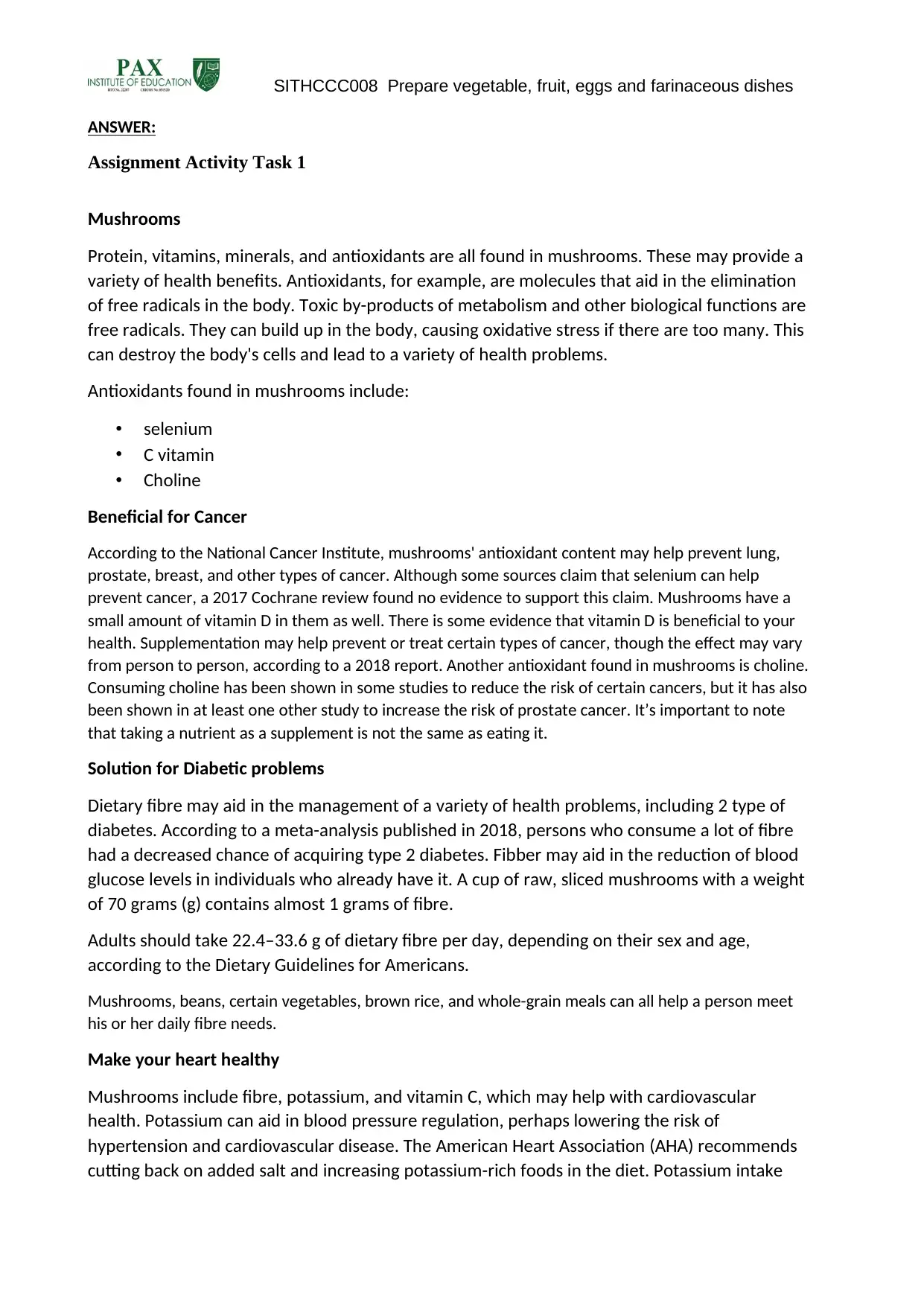
SITHCCC008 Prepare vegetable, fruit, eggs and farinaceous dishes
ANSWER:
Assignment Activity Task 1
Mushrooms
Protein, vitamins, minerals, and antioxidants are all found in mushrooms. These may provide a
variety of health benefits. Antioxidants, for example, are molecules that aid in the elimination
of free radicals in the body. Toxic by-products of metabolism and other biological functions are
free radicals. They can build up in the body, causing oxidative stress if there are too many. This
can destroy the body's cells and lead to a variety of health problems.
Antioxidants found in mushrooms include:
• selenium
• C vitamin
• Choline
Beneficial for Cancer
According to the National Cancer Institute, mushrooms' antioxidant content may help prevent lung,
prostate, breast, and other types of cancer. Although some sources claim that selenium can help
prevent cancer, a 2017 Cochrane review found no evidence to support this claim. Mushrooms have a
small amount of vitamin D in them as well. There is some evidence that vitamin D is beneficial to your
health. Supplementation may help prevent or treat certain types of cancer, though the effect may vary
from person to person, according to a 2018 report. Another antioxidant found in mushrooms is choline.
Consuming choline has been shown in some studies to reduce the risk of certain cancers, but it has also
been shown in at least one other study to increase the risk of prostate cancer. It’s important to note
that taking a nutrient as a supplement is not the same as eating it.
Solution for Diabetic problems
Dietary fibre may aid in the management of a variety of health problems, including 2 type of
diabetes. According to a meta-analysis published in 2018, persons who consume a lot of fibre
had a decreased chance of acquiring type 2 diabetes. Fibber may aid in the reduction of blood
glucose levels in individuals who already have it. A cup of raw, sliced mushrooms with a weight
of 70 grams (g) contains almost 1 grams of fibre.
Adults should take 22.4–33.6 g of dietary fibre per day, depending on their sex and age,
according to the Dietary Guidelines for Americans.
Mushrooms, beans, certain vegetables, brown rice, and whole-grain meals can all help a person meet
his or her daily fibre needs.
Make your heart healthy
Mushrooms include fibre, potassium, and vitamin C, which may help with cardiovascular
health. Potassium can aid in blood pressure regulation, perhaps lowering the risk of
hypertension and cardiovascular disease. The American Heart Association (AHA) recommends
cutting back on added salt and increasing potassium-rich foods in the diet. Potassium intake
ANSWER:
Assignment Activity Task 1
Mushrooms
Protein, vitamins, minerals, and antioxidants are all found in mushrooms. These may provide a
variety of health benefits. Antioxidants, for example, are molecules that aid in the elimination
of free radicals in the body. Toxic by-products of metabolism and other biological functions are
free radicals. They can build up in the body, causing oxidative stress if there are too many. This
can destroy the body's cells and lead to a variety of health problems.
Antioxidants found in mushrooms include:
• selenium
• C vitamin
• Choline
Beneficial for Cancer
According to the National Cancer Institute, mushrooms' antioxidant content may help prevent lung,
prostate, breast, and other types of cancer. Although some sources claim that selenium can help
prevent cancer, a 2017 Cochrane review found no evidence to support this claim. Mushrooms have a
small amount of vitamin D in them as well. There is some evidence that vitamin D is beneficial to your
health. Supplementation may help prevent or treat certain types of cancer, though the effect may vary
from person to person, according to a 2018 report. Another antioxidant found in mushrooms is choline.
Consuming choline has been shown in some studies to reduce the risk of certain cancers, but it has also
been shown in at least one other study to increase the risk of prostate cancer. It’s important to note
that taking a nutrient as a supplement is not the same as eating it.
Solution for Diabetic problems
Dietary fibre may aid in the management of a variety of health problems, including 2 type of
diabetes. According to a meta-analysis published in 2018, persons who consume a lot of fibre
had a decreased chance of acquiring type 2 diabetes. Fibber may aid in the reduction of blood
glucose levels in individuals who already have it. A cup of raw, sliced mushrooms with a weight
of 70 grams (g) contains almost 1 grams of fibre.
Adults should take 22.4–33.6 g of dietary fibre per day, depending on their sex and age,
according to the Dietary Guidelines for Americans.
Mushrooms, beans, certain vegetables, brown rice, and whole-grain meals can all help a person meet
his or her daily fibre needs.
Make your heart healthy
Mushrooms include fibre, potassium, and vitamin C, which may help with cardiovascular
health. Potassium can aid in blood pressure regulation, perhaps lowering the risk of
hypertension and cardiovascular disease. The American Heart Association (AHA) recommends
cutting back on added salt and increasing potassium-rich foods in the diet. Potassium intake
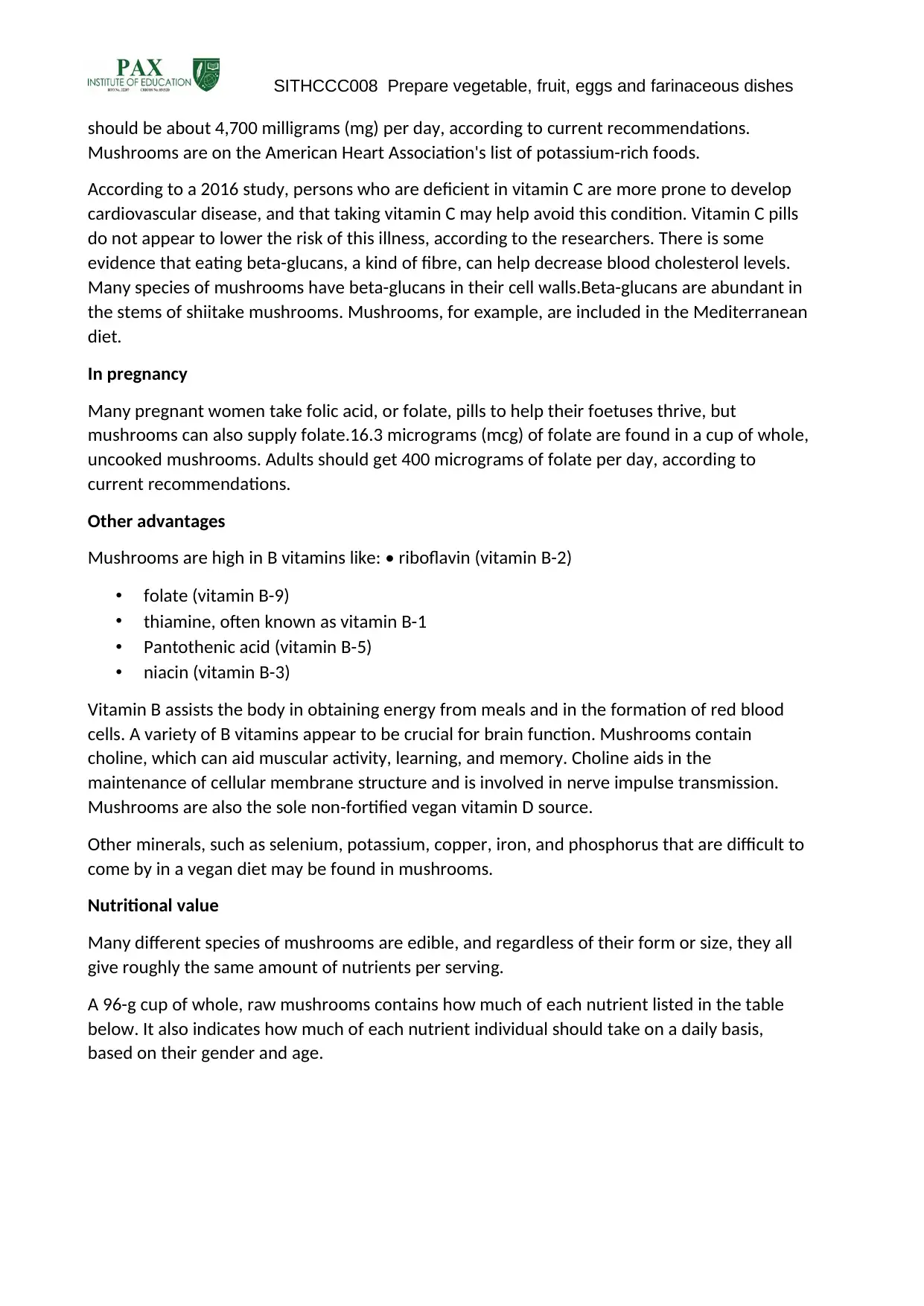
SITHCCC008 Prepare vegetable, fruit, eggs and farinaceous dishes
should be about 4,700 milligrams (mg) per day, according to current recommendations.
Mushrooms are on the American Heart Association's list of potassium-rich foods.
According to a 2016 study, persons who are deficient in vitamin C are more prone to develop
cardiovascular disease, and that taking vitamin C may help avoid this condition. Vitamin C pills
do not appear to lower the risk of this illness, according to the researchers. There is some
evidence that eating beta-glucans, a kind of fibre, can help decrease blood cholesterol levels.
Many species of mushrooms have beta-glucans in their cell walls.Beta-glucans are abundant in
the stems of shiitake mushrooms. Mushrooms, for example, are included in the Mediterranean
diet.
In pregnancy
Many pregnant women take folic acid, or folate, pills to help their foetuses thrive, but
mushrooms can also supply folate.16.3 micrograms (mcg) of folate are found in a cup of whole,
uncooked mushrooms. Adults should get 400 micrograms of folate per day, according to
current recommendations.
Other advantages
Mushrooms are high in B vitamins like: • riboflavin (vitamin B-2)
• folate (vitamin B-9)
• thiamine, often known as vitamin B-1
• Pantothenic acid (vitamin B-5)
• niacin (vitamin B-3)
Vitamin B assists the body in obtaining energy from meals and in the formation of red blood
cells. A variety of B vitamins appear to be crucial for brain function. Mushrooms contain
choline, which can aid muscular activity, learning, and memory. Choline aids in the
maintenance of cellular membrane structure and is involved in nerve impulse transmission.
Mushrooms are also the sole non-fortified vegan vitamin D source.
Other minerals, such as selenium, potassium, copper, iron, and phosphorus that are difficult to
come by in a vegan diet may be found in mushrooms.
Nutritional value
Many different species of mushrooms are edible, and regardless of their form or size, they all
give roughly the same amount of nutrients per serving.
A 96-g cup of whole, raw mushrooms contains how much of each nutrient listed in the table
below. It also indicates how much of each nutrient individual should take on a daily basis,
based on their gender and age.
should be about 4,700 milligrams (mg) per day, according to current recommendations.
Mushrooms are on the American Heart Association's list of potassium-rich foods.
According to a 2016 study, persons who are deficient in vitamin C are more prone to develop
cardiovascular disease, and that taking vitamin C may help avoid this condition. Vitamin C pills
do not appear to lower the risk of this illness, according to the researchers. There is some
evidence that eating beta-glucans, a kind of fibre, can help decrease blood cholesterol levels.
Many species of mushrooms have beta-glucans in their cell walls.Beta-glucans are abundant in
the stems of shiitake mushrooms. Mushrooms, for example, are included in the Mediterranean
diet.
In pregnancy
Many pregnant women take folic acid, or folate, pills to help their foetuses thrive, but
mushrooms can also supply folate.16.3 micrograms (mcg) of folate are found in a cup of whole,
uncooked mushrooms. Adults should get 400 micrograms of folate per day, according to
current recommendations.
Other advantages
Mushrooms are high in B vitamins like: • riboflavin (vitamin B-2)
• folate (vitamin B-9)
• thiamine, often known as vitamin B-1
• Pantothenic acid (vitamin B-5)
• niacin (vitamin B-3)
Vitamin B assists the body in obtaining energy from meals and in the formation of red blood
cells. A variety of B vitamins appear to be crucial for brain function. Mushrooms contain
choline, which can aid muscular activity, learning, and memory. Choline aids in the
maintenance of cellular membrane structure and is involved in nerve impulse transmission.
Mushrooms are also the sole non-fortified vegan vitamin D source.
Other minerals, such as selenium, potassium, copper, iron, and phosphorus that are difficult to
come by in a vegan diet may be found in mushrooms.
Nutritional value
Many different species of mushrooms are edible, and regardless of their form or size, they all
give roughly the same amount of nutrients per serving.
A 96-g cup of whole, raw mushrooms contains how much of each nutrient listed in the table
below. It also indicates how much of each nutrient individual should take on a daily basis,
based on their gender and age.
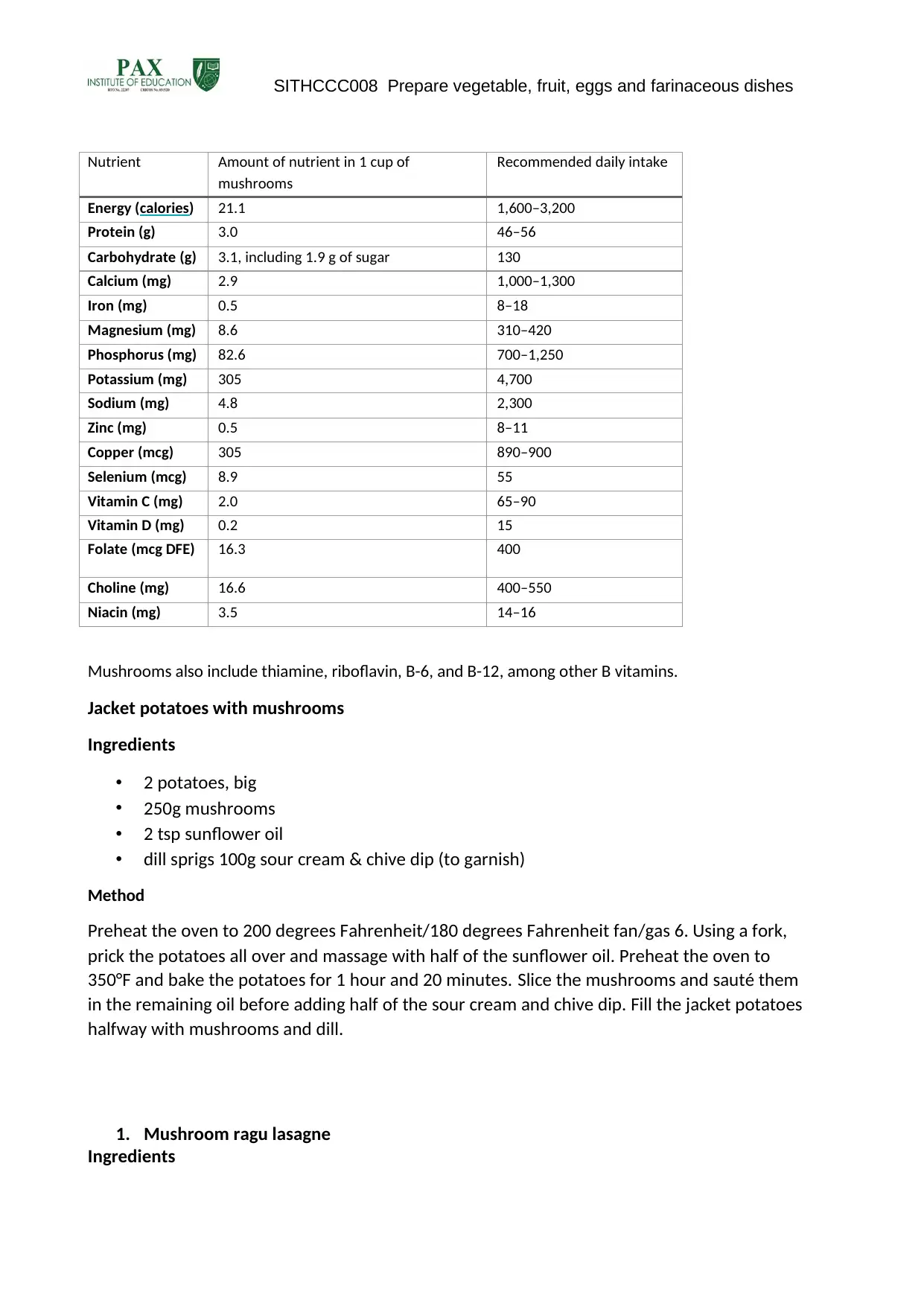
SITHCCC008 Prepare vegetable, fruit, eggs and farinaceous dishes
Nutrient Amount of nutrient in 1 cup of
mushrooms
Recommended daily intake
Energy (calories) 21.1 1,600–3,200
Protein (g) 3.0 46–56
Carbohydrate (g) 3.1, including 1.9 g of sugar 130
Calcium (mg) 2.9 1,000–1,300
Iron (mg) 0.5 8–18
Magnesium (mg) 8.6 310–420
Phosphorus (mg) 82.6 700–1,250
Potassium (mg) 305 4,700
Sodium (mg) 4.8 2,300
Zinc (mg) 0.5 8–11
Copper (mcg) 305 890–900
Selenium (mcg) 8.9 55
Vitamin C (mg) 2.0 65–90
Vitamin D (mg) 0.2 15
Folate (mcg DFE) 16.3 400
Choline (mg) 16.6 400–550
Niacin (mg) 3.5 14–16
Mushrooms also include thiamine, riboflavin, B-6, and B-12, among other B vitamins.
Jacket potatoes with mushrooms
Ingredients
• 2 potatoes, big
• 250g mushrooms
• 2 tsp sunflower oil
• dill sprigs 100g sour cream & chive dip (to garnish)
Method
Preheat the oven to 200 degrees Fahrenheit/180 degrees Fahrenheit fan/gas 6. Using a fork,
prick the potatoes all over and massage with half of the sunflower oil. Preheat the oven to
350°F and bake the potatoes for 1 hour and 20 minutes. Slice the mushrooms and sauté them
in the remaining oil before adding half of the sour cream and chive dip. Fill the jacket potatoes
halfway with mushrooms and dill.
1. Mushroom ragu lasagne
Ingredients
Nutrient Amount of nutrient in 1 cup of
mushrooms
Recommended daily intake
Energy (calories) 21.1 1,600–3,200
Protein (g) 3.0 46–56
Carbohydrate (g) 3.1, including 1.9 g of sugar 130
Calcium (mg) 2.9 1,000–1,300
Iron (mg) 0.5 8–18
Magnesium (mg) 8.6 310–420
Phosphorus (mg) 82.6 700–1,250
Potassium (mg) 305 4,700
Sodium (mg) 4.8 2,300
Zinc (mg) 0.5 8–11
Copper (mcg) 305 890–900
Selenium (mcg) 8.9 55
Vitamin C (mg) 2.0 65–90
Vitamin D (mg) 0.2 15
Folate (mcg DFE) 16.3 400
Choline (mg) 16.6 400–550
Niacin (mg) 3.5 14–16
Mushrooms also include thiamine, riboflavin, B-6, and B-12, among other B vitamins.
Jacket potatoes with mushrooms
Ingredients
• 2 potatoes, big
• 250g mushrooms
• 2 tsp sunflower oil
• dill sprigs 100g sour cream & chive dip (to garnish)
Method
Preheat the oven to 200 degrees Fahrenheit/180 degrees Fahrenheit fan/gas 6. Using a fork,
prick the potatoes all over and massage with half of the sunflower oil. Preheat the oven to
350°F and bake the potatoes for 1 hour and 20 minutes. Slice the mushrooms and sauté them
in the remaining oil before adding half of the sour cream and chive dip. Fill the jacket potatoes
halfway with mushrooms and dill.
1. Mushroom ragu lasagne
Ingredients
Secure Best Marks with AI Grader
Need help grading? Try our AI Grader for instant feedback on your assignments.
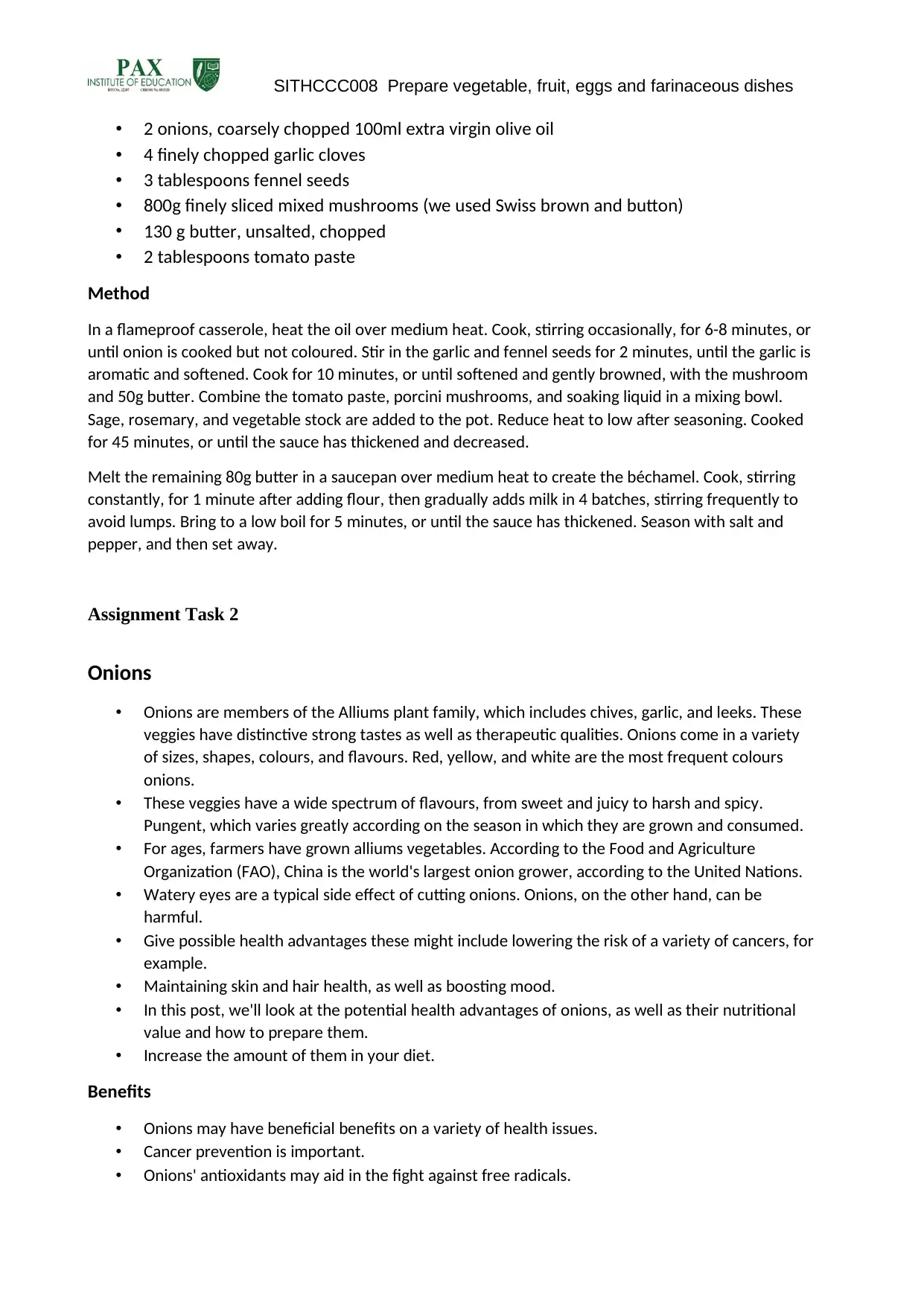
SITHCCC008 Prepare vegetable, fruit, eggs and farinaceous dishes
• 2 onions, coarsely chopped 100ml extra virgin olive oil
• 4 finely chopped garlic cloves
• 3 tablespoons fennel seeds
• 800g finely sliced mixed mushrooms (we used Swiss brown and button)
• 130 g butter, unsalted, chopped
• 2 tablespoons tomato paste
Method
In a flameproof casserole, heat the oil over medium heat. Cook, stirring occasionally, for 6-8 minutes, or
until onion is cooked but not coloured. Stir in the garlic and fennel seeds for 2 minutes, until the garlic is
aromatic and softened. Cook for 10 minutes, or until softened and gently browned, with the mushroom
and 50g butter. Combine the tomato paste, porcini mushrooms, and soaking liquid in a mixing bowl.
Sage, rosemary, and vegetable stock are added to the pot. Reduce heat to low after seasoning. Cooked
for 45 minutes, or until the sauce has thickened and decreased.
Melt the remaining 80g butter in a saucepan over medium heat to create the béchamel. Cook, stirring
constantly, for 1 minute after adding flour, then gradually adds milk in 4 batches, stirring frequently to
avoid lumps. Bring to a low boil for 5 minutes, or until the sauce has thickened. Season with salt and
pepper, and then set away.
Assignment Task 2
Onions
• Onions are members of the Alliums plant family, which includes chives, garlic, and leeks. These
veggies have distinctive strong tastes as well as therapeutic qualities. Onions come in a variety
of sizes, shapes, colours, and flavours. Red, yellow, and white are the most frequent colours
onions.
• These veggies have a wide spectrum of flavours, from sweet and juicy to harsh and spicy.
Pungent, which varies greatly according on the season in which they are grown and consumed.
• For ages, farmers have grown alliums vegetables. According to the Food and Agriculture
Organization (FAO), China is the world's largest onion grower, according to the United Nations.
• Watery eyes are a typical side effect of cutting onions. Onions, on the other hand, can be
harmful.
• Give possible health advantages these might include lowering the risk of a variety of cancers, for
example.
• Maintaining skin and hair health, as well as boosting mood.
• In this post, we'll look at the potential health advantages of onions, as well as their nutritional
value and how to prepare them.
• Increase the amount of them in your diet.
Benefits
• Onions may have beneficial benefits on a variety of health issues.
• Cancer prevention is important.
• Onions' antioxidants may aid in the fight against free radicals.
• 2 onions, coarsely chopped 100ml extra virgin olive oil
• 4 finely chopped garlic cloves
• 3 tablespoons fennel seeds
• 800g finely sliced mixed mushrooms (we used Swiss brown and button)
• 130 g butter, unsalted, chopped
• 2 tablespoons tomato paste
Method
In a flameproof casserole, heat the oil over medium heat. Cook, stirring occasionally, for 6-8 minutes, or
until onion is cooked but not coloured. Stir in the garlic and fennel seeds for 2 minutes, until the garlic is
aromatic and softened. Cook for 10 minutes, or until softened and gently browned, with the mushroom
and 50g butter. Combine the tomato paste, porcini mushrooms, and soaking liquid in a mixing bowl.
Sage, rosemary, and vegetable stock are added to the pot. Reduce heat to low after seasoning. Cooked
for 45 minutes, or until the sauce has thickened and decreased.
Melt the remaining 80g butter in a saucepan over medium heat to create the béchamel. Cook, stirring
constantly, for 1 minute after adding flour, then gradually adds milk in 4 batches, stirring frequently to
avoid lumps. Bring to a low boil for 5 minutes, or until the sauce has thickened. Season with salt and
pepper, and then set away.
Assignment Task 2
Onions
• Onions are members of the Alliums plant family, which includes chives, garlic, and leeks. These
veggies have distinctive strong tastes as well as therapeutic qualities. Onions come in a variety
of sizes, shapes, colours, and flavours. Red, yellow, and white are the most frequent colours
onions.
• These veggies have a wide spectrum of flavours, from sweet and juicy to harsh and spicy.
Pungent, which varies greatly according on the season in which they are grown and consumed.
• For ages, farmers have grown alliums vegetables. According to the Food and Agriculture
Organization (FAO), China is the world's largest onion grower, according to the United Nations.
• Watery eyes are a typical side effect of cutting onions. Onions, on the other hand, can be
harmful.
• Give possible health advantages these might include lowering the risk of a variety of cancers, for
example.
• Maintaining skin and hair health, as well as boosting mood.
• In this post, we'll look at the potential health advantages of onions, as well as their nutritional
value and how to prepare them.
• Increase the amount of them in your diet.
Benefits
• Onions may have beneficial benefits on a variety of health issues.
• Cancer prevention is important.
• Onions' antioxidants may aid in the fight against free radicals.
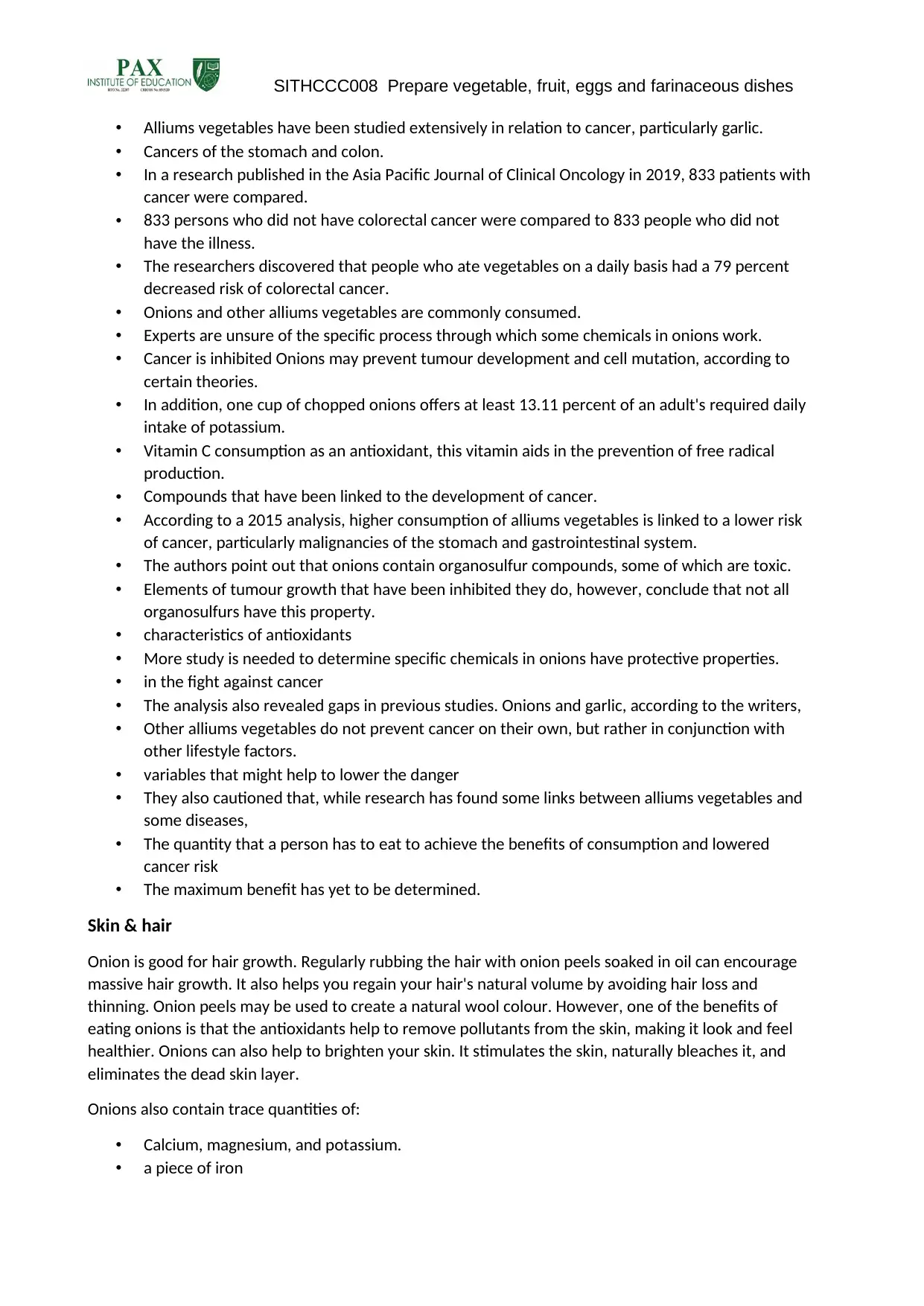
SITHCCC008 Prepare vegetable, fruit, eggs and farinaceous dishes
• Alliums vegetables have been studied extensively in relation to cancer, particularly garlic.
• Cancers of the stomach and colon.
• In a research published in the Asia Pacific Journal of Clinical Oncology in 2019, 833 patients with
cancer were compared.
• 833 persons who did not have colorectal cancer were compared to 833 people who did not
have the illness.
• The researchers discovered that people who ate vegetables on a daily basis had a 79 percent
decreased risk of colorectal cancer.
• Onions and other alliums vegetables are commonly consumed.
• Experts are unsure of the specific process through which some chemicals in onions work.
• Cancer is inhibited Onions may prevent tumour development and cell mutation, according to
certain theories.
• In addition, one cup of chopped onions offers at least 13.11 percent of an adult's required daily
intake of potassium.
• Vitamin C consumption as an antioxidant, this vitamin aids in the prevention of free radical
production.
• Compounds that have been linked to the development of cancer.
• According to a 2015 analysis, higher consumption of alliums vegetables is linked to a lower risk
of cancer, particularly malignancies of the stomach and gastrointestinal system.
• The authors point out that onions contain organosulfur compounds, some of which are toxic.
• Elements of tumour growth that have been inhibited they do, however, conclude that not all
organosulfurs have this property.
• characteristics of antioxidants
• More study is needed to determine specific chemicals in onions have protective properties.
• in the fight against cancer
• The analysis also revealed gaps in previous studies. Onions and garlic, according to the writers,
• Other alliums vegetables do not prevent cancer on their own, but rather in conjunction with
other lifestyle factors.
• variables that might help to lower the danger
• They also cautioned that, while research has found some links between alliums vegetables and
some diseases,
• The quantity that a person has to eat to achieve the benefits of consumption and lowered
cancer risk
• The maximum benefit has yet to be determined.
Skin & hair
Onion is good for hair growth. Regularly rubbing the hair with onion peels soaked in oil can encourage
massive hair growth. It also helps you regain your hair's natural volume by avoiding hair loss and
thinning. Onion peels may be used to create a natural wool colour. However, one of the benefits of
eating onions is that the antioxidants help to remove pollutants from the skin, making it look and feel
healthier. Onions can also help to brighten your skin. It stimulates the skin, naturally bleaches it, and
eliminates the dead skin layer.
Onions also contain trace quantities of:
• Calcium, magnesium, and potassium.
• a piece of iron
• Alliums vegetables have been studied extensively in relation to cancer, particularly garlic.
• Cancers of the stomach and colon.
• In a research published in the Asia Pacific Journal of Clinical Oncology in 2019, 833 patients with
cancer were compared.
• 833 persons who did not have colorectal cancer were compared to 833 people who did not
have the illness.
• The researchers discovered that people who ate vegetables on a daily basis had a 79 percent
decreased risk of colorectal cancer.
• Onions and other alliums vegetables are commonly consumed.
• Experts are unsure of the specific process through which some chemicals in onions work.
• Cancer is inhibited Onions may prevent tumour development and cell mutation, according to
certain theories.
• In addition, one cup of chopped onions offers at least 13.11 percent of an adult's required daily
intake of potassium.
• Vitamin C consumption as an antioxidant, this vitamin aids in the prevention of free radical
production.
• Compounds that have been linked to the development of cancer.
• According to a 2015 analysis, higher consumption of alliums vegetables is linked to a lower risk
of cancer, particularly malignancies of the stomach and gastrointestinal system.
• The authors point out that onions contain organosulfur compounds, some of which are toxic.
• Elements of tumour growth that have been inhibited they do, however, conclude that not all
organosulfurs have this property.
• characteristics of antioxidants
• More study is needed to determine specific chemicals in onions have protective properties.
• in the fight against cancer
• The analysis also revealed gaps in previous studies. Onions and garlic, according to the writers,
• Other alliums vegetables do not prevent cancer on their own, but rather in conjunction with
other lifestyle factors.
• variables that might help to lower the danger
• They also cautioned that, while research has found some links between alliums vegetables and
some diseases,
• The quantity that a person has to eat to achieve the benefits of consumption and lowered
cancer risk
• The maximum benefit has yet to be determined.
Skin & hair
Onion is good for hair growth. Regularly rubbing the hair with onion peels soaked in oil can encourage
massive hair growth. It also helps you regain your hair's natural volume by avoiding hair loss and
thinning. Onion peels may be used to create a natural wool colour. However, one of the benefits of
eating onions is that the antioxidants help to remove pollutants from the skin, making it look and feel
healthier. Onions can also help to brighten your skin. It stimulates the skin, naturally bleaches it, and
eliminates the dead skin layer.
Onions also contain trace quantities of:
• Calcium, magnesium, and potassium.
• a piece of iron
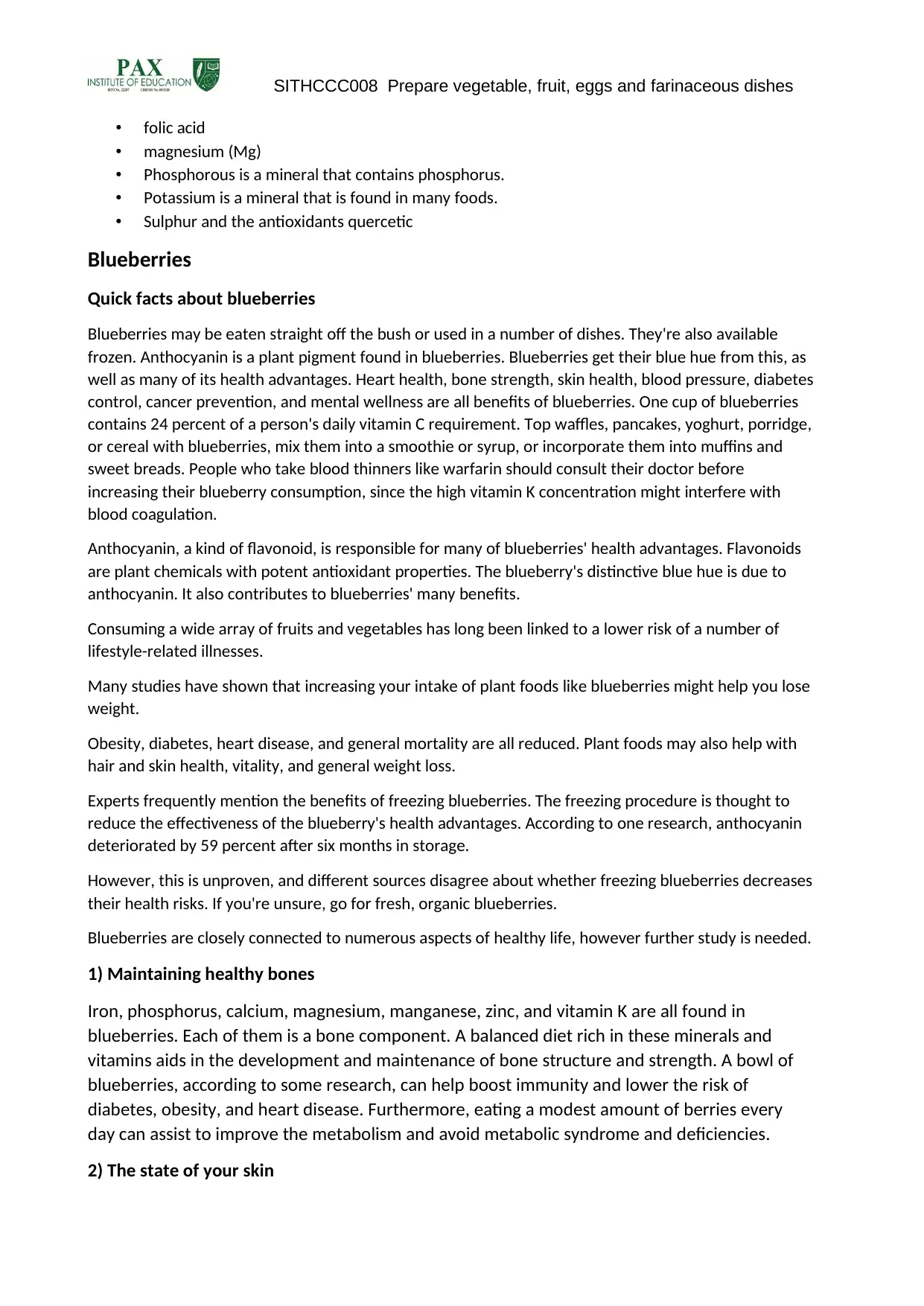
SITHCCC008 Prepare vegetable, fruit, eggs and farinaceous dishes
• folic acid
• magnesium (Mg)
• Phosphorous is a mineral that contains phosphorus.
• Potassium is a mineral that is found in many foods.
• Sulphur and the antioxidants quercetic
Blueberries
Quick facts about blueberries
Blueberries may be eaten straight off the bush or used in a number of dishes. They're also available
frozen. Anthocyanin is a plant pigment found in blueberries. Blueberries get their blue hue from this, as
well as many of its health advantages. Heart health, bone strength, skin health, blood pressure, diabetes
control, cancer prevention, and mental wellness are all benefits of blueberries. One cup of blueberries
contains 24 percent of a person's daily vitamin C requirement. Top waffles, pancakes, yoghurt, porridge,
or cereal with blueberries, mix them into a smoothie or syrup, or incorporate them into muffins and
sweet breads. People who take blood thinners like warfarin should consult their doctor before
increasing their blueberry consumption, since the high vitamin K concentration might interfere with
blood coagulation.
Anthocyanin, a kind of flavonoid, is responsible for many of blueberries' health advantages. Flavonoids
are plant chemicals with potent antioxidant properties. The blueberry's distinctive blue hue is due to
anthocyanin. It also contributes to blueberries' many benefits.
Consuming a wide array of fruits and vegetables has long been linked to a lower risk of a number of
lifestyle-related illnesses.
Many studies have shown that increasing your intake of plant foods like blueberries might help you lose
weight.
Obesity, diabetes, heart disease, and general mortality are all reduced. Plant foods may also help with
hair and skin health, vitality, and general weight loss.
Experts frequently mention the benefits of freezing blueberries. The freezing procedure is thought to
reduce the effectiveness of the blueberry's health advantages. According to one research, anthocyanin
deteriorated by 59 percent after six months in storage.
However, this is unproven, and different sources disagree about whether freezing blueberries decreases
their health risks. If you're unsure, go for fresh, organic blueberries.
Blueberries are closely connected to numerous aspects of healthy life, however further study is needed.
1) Maintaining healthy bones
Iron, phosphorus, calcium, magnesium, manganese, zinc, and vitamin K are all found in
blueberries. Each of them is a bone component. A balanced diet rich in these minerals and
vitamins aids in the development and maintenance of bone structure and strength. A bowl of
blueberries, according to some research, can help boost immunity and lower the risk of
diabetes, obesity, and heart disease. Furthermore, eating a modest amount of berries every
day can assist to improve the metabolism and avoid metabolic syndrome and deficiencies.
2) The state of your skin
• folic acid
• magnesium (Mg)
• Phosphorous is a mineral that contains phosphorus.
• Potassium is a mineral that is found in many foods.
• Sulphur and the antioxidants quercetic
Blueberries
Quick facts about blueberries
Blueberries may be eaten straight off the bush or used in a number of dishes. They're also available
frozen. Anthocyanin is a plant pigment found in blueberries. Blueberries get their blue hue from this, as
well as many of its health advantages. Heart health, bone strength, skin health, blood pressure, diabetes
control, cancer prevention, and mental wellness are all benefits of blueberries. One cup of blueberries
contains 24 percent of a person's daily vitamin C requirement. Top waffles, pancakes, yoghurt, porridge,
or cereal with blueberries, mix them into a smoothie or syrup, or incorporate them into muffins and
sweet breads. People who take blood thinners like warfarin should consult their doctor before
increasing their blueberry consumption, since the high vitamin K concentration might interfere with
blood coagulation.
Anthocyanin, a kind of flavonoid, is responsible for many of blueberries' health advantages. Flavonoids
are plant chemicals with potent antioxidant properties. The blueberry's distinctive blue hue is due to
anthocyanin. It also contributes to blueberries' many benefits.
Consuming a wide array of fruits and vegetables has long been linked to a lower risk of a number of
lifestyle-related illnesses.
Many studies have shown that increasing your intake of plant foods like blueberries might help you lose
weight.
Obesity, diabetes, heart disease, and general mortality are all reduced. Plant foods may also help with
hair and skin health, vitality, and general weight loss.
Experts frequently mention the benefits of freezing blueberries. The freezing procedure is thought to
reduce the effectiveness of the blueberry's health advantages. According to one research, anthocyanin
deteriorated by 59 percent after six months in storage.
However, this is unproven, and different sources disagree about whether freezing blueberries decreases
their health risks. If you're unsure, go for fresh, organic blueberries.
Blueberries are closely connected to numerous aspects of healthy life, however further study is needed.
1) Maintaining healthy bones
Iron, phosphorus, calcium, magnesium, manganese, zinc, and vitamin K are all found in
blueberries. Each of them is a bone component. A balanced diet rich in these minerals and
vitamins aids in the development and maintenance of bone structure and strength. A bowl of
blueberries, according to some research, can help boost immunity and lower the risk of
diabetes, obesity, and heart disease. Furthermore, eating a modest amount of berries every
day can assist to improve the metabolism and avoid metabolic syndrome and deficiencies.
2) The state of your skin
Paraphrase This Document
Need a fresh take? Get an instant paraphrase of this document with our AI Paraphraser
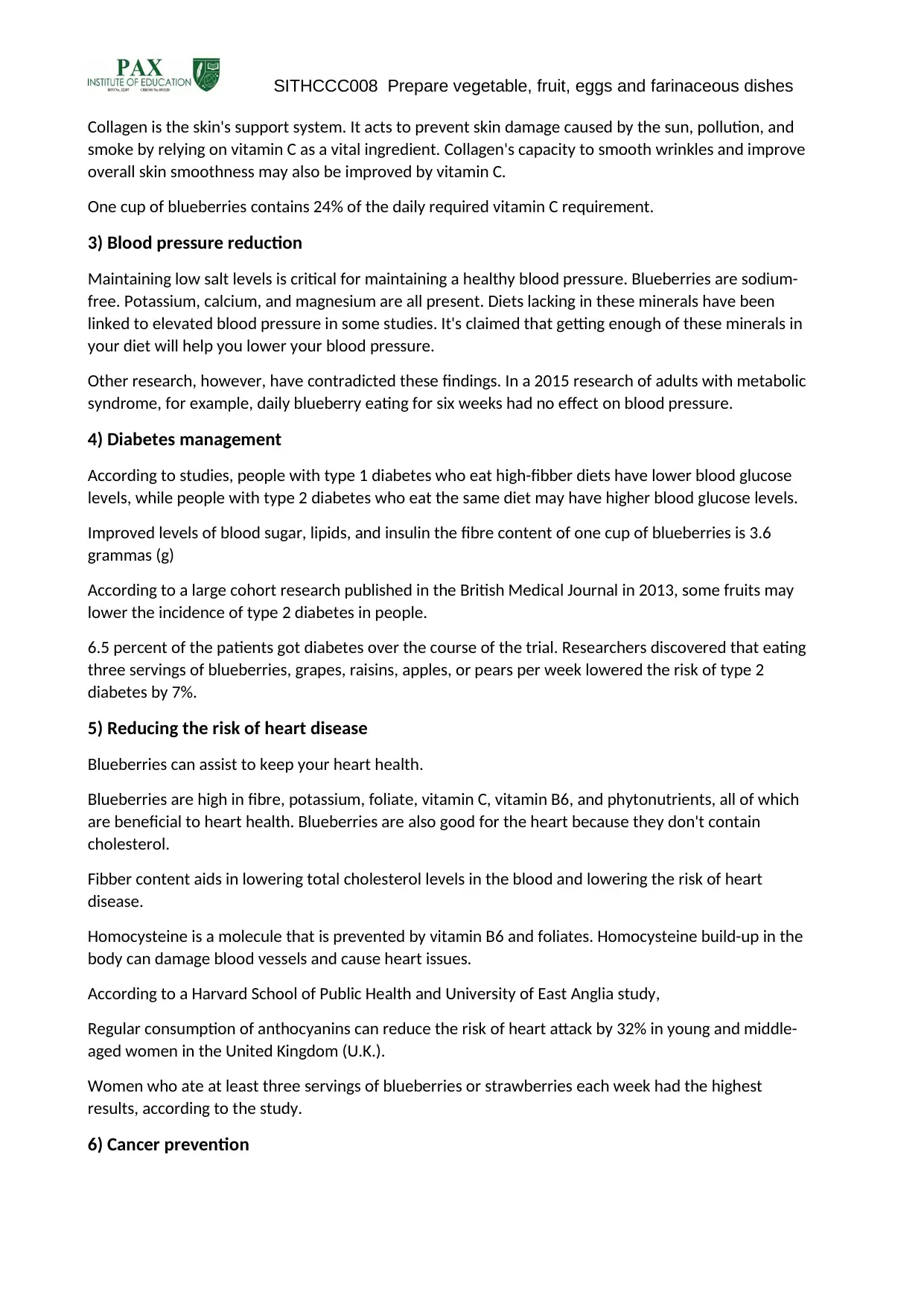
SITHCCC008 Prepare vegetable, fruit, eggs and farinaceous dishes
Collagen is the skin's support system. It acts to prevent skin damage caused by the sun, pollution, and
smoke by relying on vitamin C as a vital ingredient. Collagen's capacity to smooth wrinkles and improve
overall skin smoothness may also be improved by vitamin C.
One cup of blueberries contains 24% of the daily required vitamin C requirement.
3) Blood pressure reduction
Maintaining low salt levels is critical for maintaining a healthy blood pressure. Blueberries are sodium-
free. Potassium, calcium, and magnesium are all present. Diets lacking in these minerals have been
linked to elevated blood pressure in some studies. It's claimed that getting enough of these minerals in
your diet will help you lower your blood pressure.
Other research, however, have contradicted these findings. In a 2015 research of adults with metabolic
syndrome, for example, daily blueberry eating for six weeks had no effect on blood pressure.
4) Diabetes management
According to studies, people with type 1 diabetes who eat high-fibber diets have lower blood glucose
levels, while people with type 2 diabetes who eat the same diet may have higher blood glucose levels.
Improved levels of blood sugar, lipids, and insulin the fibre content of one cup of blueberries is 3.6
grammas (g)
According to a large cohort research published in the British Medical Journal in 2013, some fruits may
lower the incidence of type 2 diabetes in people.
6.5 percent of the patients got diabetes over the course of the trial. Researchers discovered that eating
three servings of blueberries, grapes, raisins, apples, or pears per week lowered the risk of type 2
diabetes by 7%.
5) Reducing the risk of heart disease
Blueberries can assist to keep your heart health.
Blueberries are high in fibre, potassium, foliate, vitamin C, vitamin B6, and phytonutrients, all of which
are beneficial to heart health. Blueberries are also good for the heart because they don't contain
cholesterol.
Fibber content aids in lowering total cholesterol levels in the blood and lowering the risk of heart
disease.
Homocysteine is a molecule that is prevented by vitamin B6 and foliates. Homocysteine build-up in the
body can damage blood vessels and cause heart issues.
According to a Harvard School of Public Health and University of East Anglia study,
Regular consumption of anthocyanins can reduce the risk of heart attack by 32% in young and middle-
aged women in the United Kingdom (U.K.).
Women who ate at least three servings of blueberries or strawberries each week had the highest
results, according to the study.
6) Cancer prevention
Collagen is the skin's support system. It acts to prevent skin damage caused by the sun, pollution, and
smoke by relying on vitamin C as a vital ingredient. Collagen's capacity to smooth wrinkles and improve
overall skin smoothness may also be improved by vitamin C.
One cup of blueberries contains 24% of the daily required vitamin C requirement.
3) Blood pressure reduction
Maintaining low salt levels is critical for maintaining a healthy blood pressure. Blueberries are sodium-
free. Potassium, calcium, and magnesium are all present. Diets lacking in these minerals have been
linked to elevated blood pressure in some studies. It's claimed that getting enough of these minerals in
your diet will help you lower your blood pressure.
Other research, however, have contradicted these findings. In a 2015 research of adults with metabolic
syndrome, for example, daily blueberry eating for six weeks had no effect on blood pressure.
4) Diabetes management
According to studies, people with type 1 diabetes who eat high-fibber diets have lower blood glucose
levels, while people with type 2 diabetes who eat the same diet may have higher blood glucose levels.
Improved levels of blood sugar, lipids, and insulin the fibre content of one cup of blueberries is 3.6
grammas (g)
According to a large cohort research published in the British Medical Journal in 2013, some fruits may
lower the incidence of type 2 diabetes in people.
6.5 percent of the patients got diabetes over the course of the trial. Researchers discovered that eating
three servings of blueberries, grapes, raisins, apples, or pears per week lowered the risk of type 2
diabetes by 7%.
5) Reducing the risk of heart disease
Blueberries can assist to keep your heart health.
Blueberries are high in fibre, potassium, foliate, vitamin C, vitamin B6, and phytonutrients, all of which
are beneficial to heart health. Blueberries are also good for the heart because they don't contain
cholesterol.
Fibber content aids in lowering total cholesterol levels in the blood and lowering the risk of heart
disease.
Homocysteine is a molecule that is prevented by vitamin B6 and foliates. Homocysteine build-up in the
body can damage blood vessels and cause heart issues.
According to a Harvard School of Public Health and University of East Anglia study,
Regular consumption of anthocyanins can reduce the risk of heart attack by 32% in young and middle-
aged women in the United Kingdom (U.K.).
Women who ate at least three servings of blueberries or strawberries each week had the highest
results, according to the study.
6) Cancer prevention
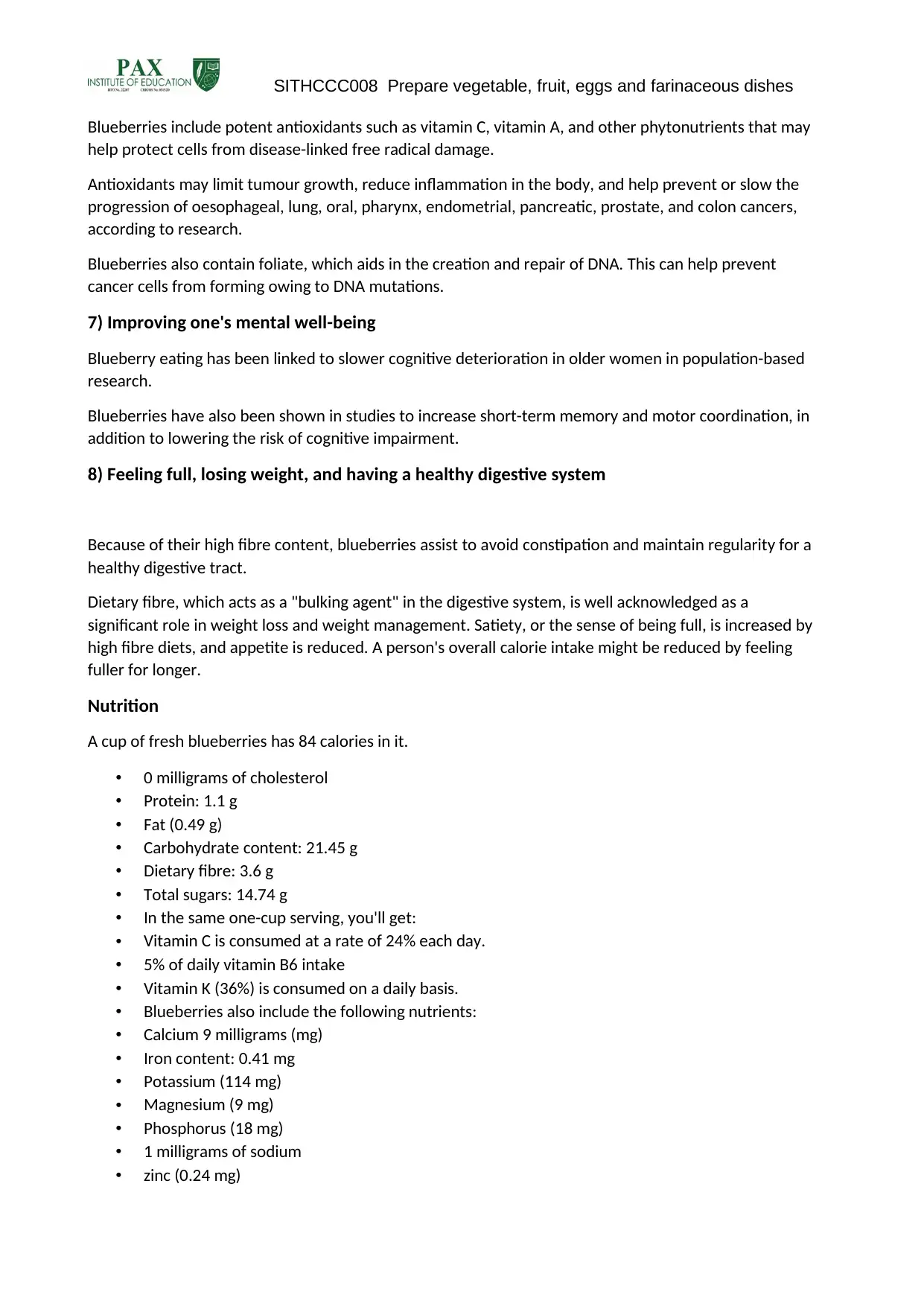
SITHCCC008 Prepare vegetable, fruit, eggs and farinaceous dishes
Blueberries include potent antioxidants such as vitamin C, vitamin A, and other phytonutrients that may
help protect cells from disease-linked free radical damage.
Antioxidants may limit tumour growth, reduce inflammation in the body, and help prevent or slow the
progression of oesophageal, lung, oral, pharynx, endometrial, pancreatic, prostate, and colon cancers,
according to research.
Blueberries also contain foliate, which aids in the creation and repair of DNA. This can help prevent
cancer cells from forming owing to DNA mutations.
7) Improving one's mental well-being
Blueberry eating has been linked to slower cognitive deterioration in older women in population-based
research.
Blueberries have also been shown in studies to increase short-term memory and motor coordination, in
addition to lowering the risk of cognitive impairment.
8) Feeling full, losing weight, and having a healthy digestive system
Because of their high fibre content, blueberries assist to avoid constipation and maintain regularity for a
healthy digestive tract.
Dietary fibre, which acts as a "bulking agent" in the digestive system, is well acknowledged as a
significant role in weight loss and weight management. Satiety, or the sense of being full, is increased by
high fibre diets, and appetite is reduced. A person's overall calorie intake might be reduced by feeling
fuller for longer.
Nutrition
A cup of fresh blueberries has 84 calories in it.
• 0 milligrams of cholesterol
• Protein: 1.1 g
• Fat (0.49 g)
• Carbohydrate content: 21.45 g
• Dietary fibre: 3.6 g
• Total sugars: 14.74 g
• In the same one-cup serving, you'll get:
• Vitamin C is consumed at a rate of 24% each day.
• 5% of daily vitamin B6 intake
• Vitamin K (36%) is consumed on a daily basis.
• Blueberries also include the following nutrients:
• Calcium 9 milligrams (mg)
• Iron content: 0.41 mg
• Potassium (114 mg)
• Magnesium (9 mg)
• Phosphorus (18 mg)
• 1 milligrams of sodium
• zinc (0.24 mg)
Blueberries include potent antioxidants such as vitamin C, vitamin A, and other phytonutrients that may
help protect cells from disease-linked free radical damage.
Antioxidants may limit tumour growth, reduce inflammation in the body, and help prevent or slow the
progression of oesophageal, lung, oral, pharynx, endometrial, pancreatic, prostate, and colon cancers,
according to research.
Blueberries also contain foliate, which aids in the creation and repair of DNA. This can help prevent
cancer cells from forming owing to DNA mutations.
7) Improving one's mental well-being
Blueberry eating has been linked to slower cognitive deterioration in older women in population-based
research.
Blueberries have also been shown in studies to increase short-term memory and motor coordination, in
addition to lowering the risk of cognitive impairment.
8) Feeling full, losing weight, and having a healthy digestive system
Because of their high fibre content, blueberries assist to avoid constipation and maintain regularity for a
healthy digestive tract.
Dietary fibre, which acts as a "bulking agent" in the digestive system, is well acknowledged as a
significant role in weight loss and weight management. Satiety, or the sense of being full, is increased by
high fibre diets, and appetite is reduced. A person's overall calorie intake might be reduced by feeling
fuller for longer.
Nutrition
A cup of fresh blueberries has 84 calories in it.
• 0 milligrams of cholesterol
• Protein: 1.1 g
• Fat (0.49 g)
• Carbohydrate content: 21.45 g
• Dietary fibre: 3.6 g
• Total sugars: 14.74 g
• In the same one-cup serving, you'll get:
• Vitamin C is consumed at a rate of 24% each day.
• 5% of daily vitamin B6 intake
• Vitamin K (36%) is consumed on a daily basis.
• Blueberries also include the following nutrients:
• Calcium 9 milligrams (mg)
• Iron content: 0.41 mg
• Potassium (114 mg)
• Magnesium (9 mg)
• Phosphorus (18 mg)
• 1 milligrams of sodium
• zinc (0.24 mg)
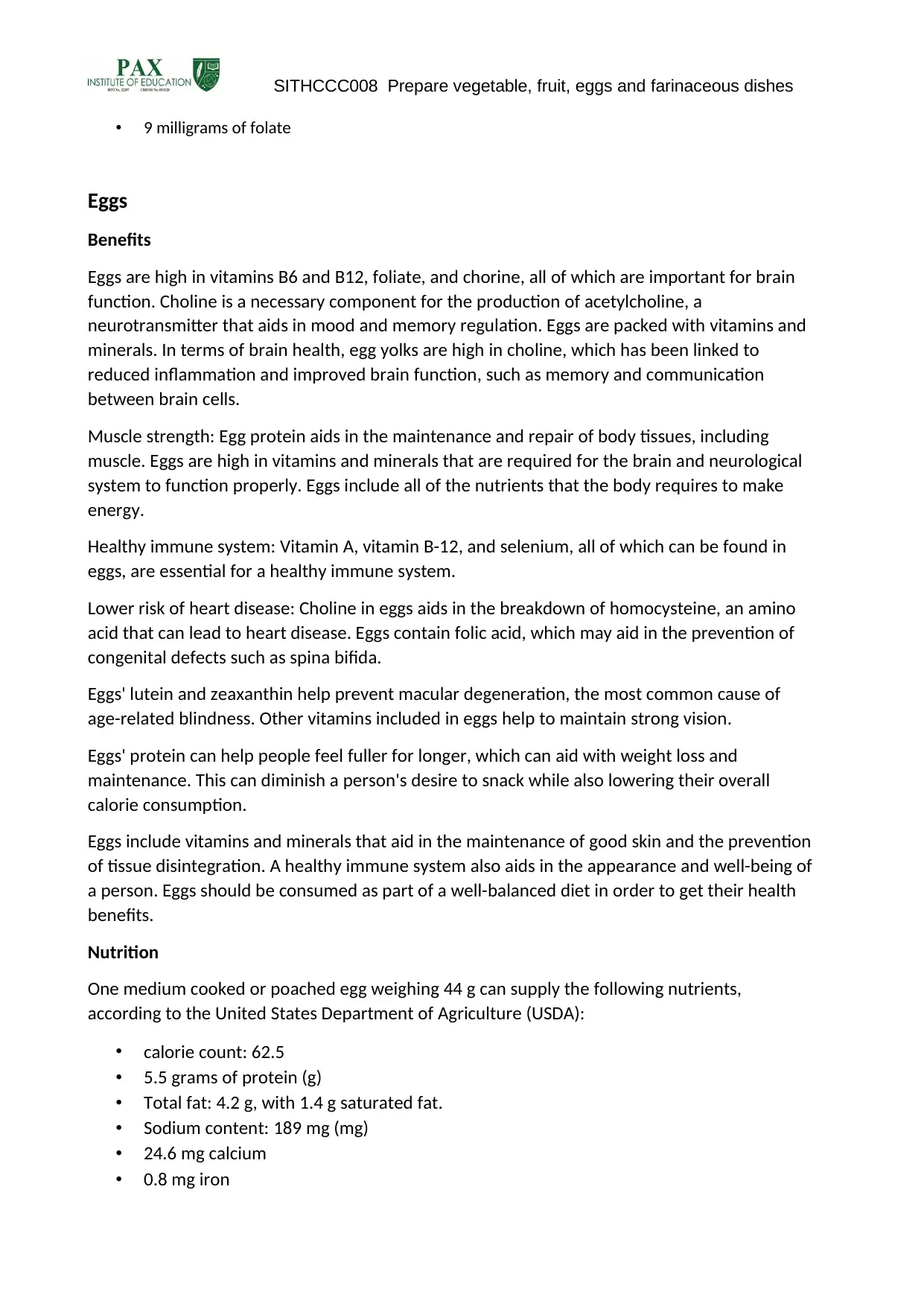
SITHCCC008 Prepare vegetable, fruit, eggs and farinaceous dishes
• 9 milligrams of folate
Eggs
Benefits
Eggs are high in vitamins B6 and B12, foliate, and chorine, all of which are important for brain
function. Choline is a necessary component for the production of acetylcholine, a
neurotransmitter that aids in mood and memory regulation. Eggs are packed with vitamins and
minerals. In terms of brain health, egg yolks are high in choline, which has been linked to
reduced inflammation and improved brain function, such as memory and communication
between brain cells.
Muscle strength: Egg protein aids in the maintenance and repair of body tissues, including
muscle. Eggs are high in vitamins and minerals that are required for the brain and neurological
system to function properly. Eggs include all of the nutrients that the body requires to make
energy.
Healthy immune system: Vitamin A, vitamin B-12, and selenium, all of which can be found in
eggs, are essential for a healthy immune system.
Lower risk of heart disease: Choline in eggs aids in the breakdown of homocysteine, an amino
acid that can lead to heart disease. Eggs contain folic acid, which may aid in the prevention of
congenital defects such as spina bifida.
Eggs' lutein and zeaxanthin help prevent macular degeneration, the most common cause of
age-related blindness. Other vitamins included in eggs help to maintain strong vision.
Eggs' protein can help people feel fuller for longer, which can aid with weight loss and
maintenance. This can diminish a person's desire to snack while also lowering their overall
calorie consumption.
Eggs include vitamins and minerals that aid in the maintenance of good skin and the prevention
of tissue disintegration. A healthy immune system also aids in the appearance and well-being of
a person. Eggs should be consumed as part of a well-balanced diet in order to get their health
benefits.
Nutrition
One medium cooked or poached egg weighing 44 g can supply the following nutrients,
according to the United States Department of Agriculture (USDA):
• calorie count: 62.5
• 5.5 grams of protein (g)
• Total fat: 4.2 g, with 1.4 g saturated fat.
• Sodium content: 189 mg (mg)
• 24.6 mg calcium
• 0.8 mg iron
• 9 milligrams of folate
Eggs
Benefits
Eggs are high in vitamins B6 and B12, foliate, and chorine, all of which are important for brain
function. Choline is a necessary component for the production of acetylcholine, a
neurotransmitter that aids in mood and memory regulation. Eggs are packed with vitamins and
minerals. In terms of brain health, egg yolks are high in choline, which has been linked to
reduced inflammation and improved brain function, such as memory and communication
between brain cells.
Muscle strength: Egg protein aids in the maintenance and repair of body tissues, including
muscle. Eggs are high in vitamins and minerals that are required for the brain and neurological
system to function properly. Eggs include all of the nutrients that the body requires to make
energy.
Healthy immune system: Vitamin A, vitamin B-12, and selenium, all of which can be found in
eggs, are essential for a healthy immune system.
Lower risk of heart disease: Choline in eggs aids in the breakdown of homocysteine, an amino
acid that can lead to heart disease. Eggs contain folic acid, which may aid in the prevention of
congenital defects such as spina bifida.
Eggs' lutein and zeaxanthin help prevent macular degeneration, the most common cause of
age-related blindness. Other vitamins included in eggs help to maintain strong vision.
Eggs' protein can help people feel fuller for longer, which can aid with weight loss and
maintenance. This can diminish a person's desire to snack while also lowering their overall
calorie consumption.
Eggs include vitamins and minerals that aid in the maintenance of good skin and the prevention
of tissue disintegration. A healthy immune system also aids in the appearance and well-being of
a person. Eggs should be consumed as part of a well-balanced diet in order to get their health
benefits.
Nutrition
One medium cooked or poached egg weighing 44 g can supply the following nutrients,
according to the United States Department of Agriculture (USDA):
• calorie count: 62.5
• 5.5 grams of protein (g)
• Total fat: 4.2 g, with 1.4 g saturated fat.
• Sodium content: 189 mg (mg)
• 24.6 mg calcium
• 0.8 mg iron
Secure Best Marks with AI Grader
Need help grading? Try our AI Grader for instant feedback on your assignments.
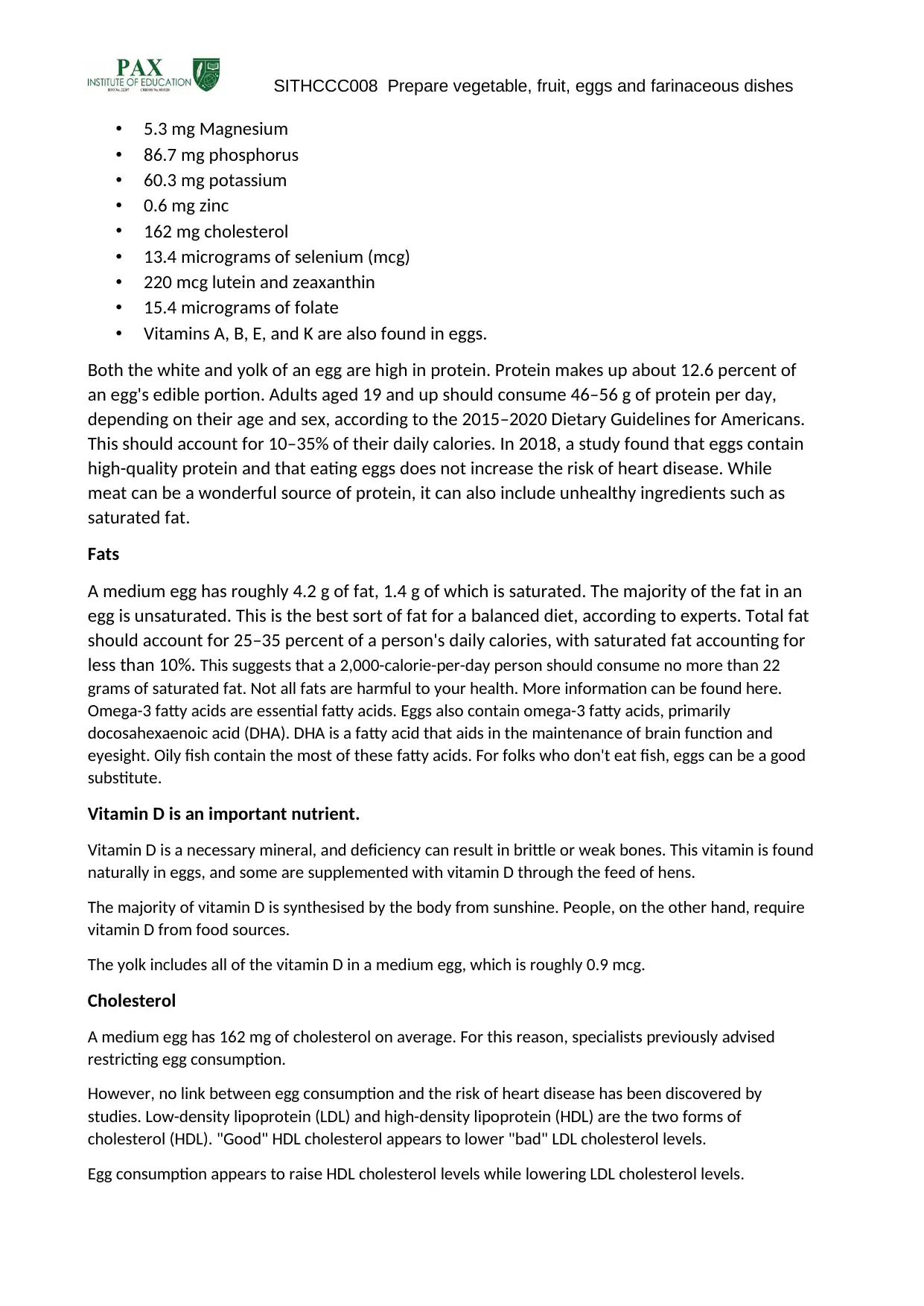
SITHCCC008 Prepare vegetable, fruit, eggs and farinaceous dishes
• 5.3 mg Magnesium
• 86.7 mg phosphorus
• 60.3 mg potassium
• 0.6 mg zinc
• 162 mg cholesterol
• 13.4 micrograms of selenium (mcg)
• 220 mcg lutein and zeaxanthin
• 15.4 micrograms of folate
• Vitamins A, B, E, and K are also found in eggs.
Both the white and yolk of an egg are high in protein. Protein makes up about 12.6 percent of
an egg's edible portion. Adults aged 19 and up should consume 46–56 g of protein per day,
depending on their age and sex, according to the 2015–2020 Dietary Guidelines for Americans.
This should account for 10–35% of their daily calories. In 2018, a study found that eggs contain
high-quality protein and that eating eggs does not increase the risk of heart disease. While
meat can be a wonderful source of protein, it can also include unhealthy ingredients such as
saturated fat.
Fats
A medium egg has roughly 4.2 g of fat, 1.4 g of which is saturated. The majority of the fat in an
egg is unsaturated. This is the best sort of fat for a balanced diet, according to experts. Total fat
should account for 25–35 percent of a person's daily calories, with saturated fat accounting for
less than 10%. This suggests that a 2,000-calorie-per-day person should consume no more than 22
grams of saturated fat. Not all fats are harmful to your health. More information can be found here.
Omega-3 fatty acids are essential fatty acids. Eggs also contain omega-3 fatty acids, primarily
docosahexaenoic acid (DHA). DHA is a fatty acid that aids in the maintenance of brain function and
eyesight. Oily fish contain the most of these fatty acids. For folks who don't eat fish, eggs can be a good
substitute.
Vitamin D is an important nutrient.
Vitamin D is a necessary mineral, and deficiency can result in brittle or weak bones. This vitamin is found
naturally in eggs, and some are supplemented with vitamin D through the feed of hens.
The majority of vitamin D is synthesised by the body from sunshine. People, on the other hand, require
vitamin D from food sources.
The yolk includes all of the vitamin D in a medium egg, which is roughly 0.9 mcg.
Cholesterol
A medium egg has 162 mg of cholesterol on average. For this reason, specialists previously advised
restricting egg consumption.
However, no link between egg consumption and the risk of heart disease has been discovered by
studies. Low-density lipoprotein (LDL) and high-density lipoprotein (HDL) are the two forms of
cholesterol (HDL). "Good" HDL cholesterol appears to lower "bad" LDL cholesterol levels.
Egg consumption appears to raise HDL cholesterol levels while lowering LDL cholesterol levels.
• 5.3 mg Magnesium
• 86.7 mg phosphorus
• 60.3 mg potassium
• 0.6 mg zinc
• 162 mg cholesterol
• 13.4 micrograms of selenium (mcg)
• 220 mcg lutein and zeaxanthin
• 15.4 micrograms of folate
• Vitamins A, B, E, and K are also found in eggs.
Both the white and yolk of an egg are high in protein. Protein makes up about 12.6 percent of
an egg's edible portion. Adults aged 19 and up should consume 46–56 g of protein per day,
depending on their age and sex, according to the 2015–2020 Dietary Guidelines for Americans.
This should account for 10–35% of their daily calories. In 2018, a study found that eggs contain
high-quality protein and that eating eggs does not increase the risk of heart disease. While
meat can be a wonderful source of protein, it can also include unhealthy ingredients such as
saturated fat.
Fats
A medium egg has roughly 4.2 g of fat, 1.4 g of which is saturated. The majority of the fat in an
egg is unsaturated. This is the best sort of fat for a balanced diet, according to experts. Total fat
should account for 25–35 percent of a person's daily calories, with saturated fat accounting for
less than 10%. This suggests that a 2,000-calorie-per-day person should consume no more than 22
grams of saturated fat. Not all fats are harmful to your health. More information can be found here.
Omega-3 fatty acids are essential fatty acids. Eggs also contain omega-3 fatty acids, primarily
docosahexaenoic acid (DHA). DHA is a fatty acid that aids in the maintenance of brain function and
eyesight. Oily fish contain the most of these fatty acids. For folks who don't eat fish, eggs can be a good
substitute.
Vitamin D is an important nutrient.
Vitamin D is a necessary mineral, and deficiency can result in brittle or weak bones. This vitamin is found
naturally in eggs, and some are supplemented with vitamin D through the feed of hens.
The majority of vitamin D is synthesised by the body from sunshine. People, on the other hand, require
vitamin D from food sources.
The yolk includes all of the vitamin D in a medium egg, which is roughly 0.9 mcg.
Cholesterol
A medium egg has 162 mg of cholesterol on average. For this reason, specialists previously advised
restricting egg consumption.
However, no link between egg consumption and the risk of heart disease has been discovered by
studies. Low-density lipoprotein (LDL) and high-density lipoprotein (HDL) are the two forms of
cholesterol (HDL). "Good" HDL cholesterol appears to lower "bad" LDL cholesterol levels.
Egg consumption appears to raise HDL cholesterol levels while lowering LDL cholesterol levels.
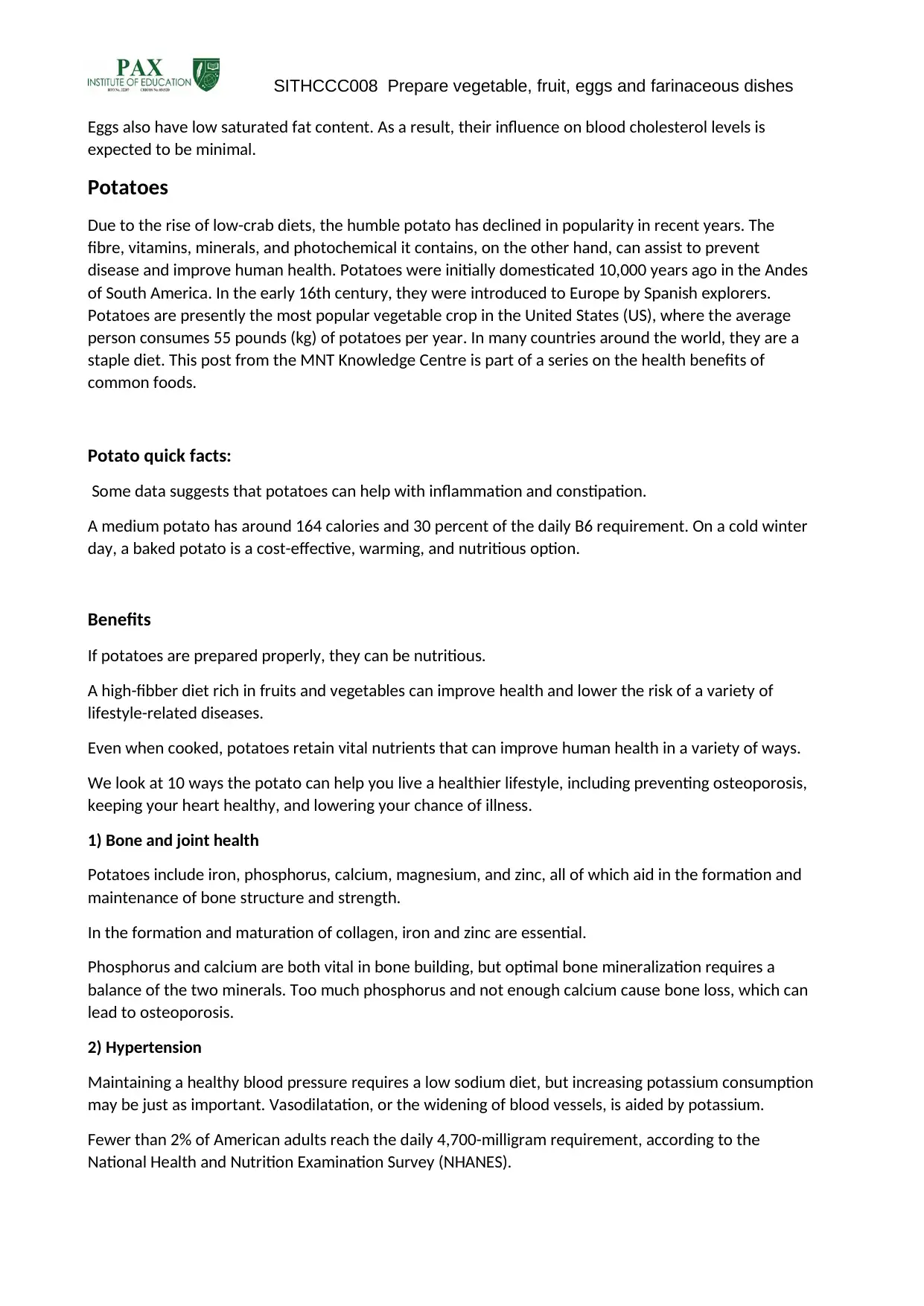
SITHCCC008 Prepare vegetable, fruit, eggs and farinaceous dishes
Eggs also have low saturated fat content. As a result, their influence on blood cholesterol levels is
expected to be minimal.
Potatoes
Due to the rise of low-crab diets, the humble potato has declined in popularity in recent years. The
fibre, vitamins, minerals, and photochemical it contains, on the other hand, can assist to prevent
disease and improve human health. Potatoes were initially domesticated 10,000 years ago in the Andes
of South America. In the early 16th century, they were introduced to Europe by Spanish explorers.
Potatoes are presently the most popular vegetable crop in the United States (US), where the average
person consumes 55 pounds (kg) of potatoes per year. In many countries around the world, they are a
staple diet. This post from the MNT Knowledge Centre is part of a series on the health benefits of
common foods.
Potato quick facts:
Some data suggests that potatoes can help with inflammation and constipation.
A medium potato has around 164 calories and 30 percent of the daily B6 requirement. On a cold winter
day, a baked potato is a cost-effective, warming, and nutritious option.
Benefits
If potatoes are prepared properly, they can be nutritious.
A high-fibber diet rich in fruits and vegetables can improve health and lower the risk of a variety of
lifestyle-related diseases.
Even when cooked, potatoes retain vital nutrients that can improve human health in a variety of ways.
We look at 10 ways the potato can help you live a healthier lifestyle, including preventing osteoporosis,
keeping your heart healthy, and lowering your chance of illness.
1) Bone and joint health
Potatoes include iron, phosphorus, calcium, magnesium, and zinc, all of which aid in the formation and
maintenance of bone structure and strength.
In the formation and maturation of collagen, iron and zinc are essential.
Phosphorus and calcium are both vital in bone building, but optimal bone mineralization requires a
balance of the two minerals. Too much phosphorus and not enough calcium cause bone loss, which can
lead to osteoporosis.
2) Hypertension
Maintaining a healthy blood pressure requires a low sodium diet, but increasing potassium consumption
may be just as important. Vasodilatation, or the widening of blood vessels, is aided by potassium.
Fewer than 2% of American adults reach the daily 4,700-milligram requirement, according to the
National Health and Nutrition Examination Survey (NHANES).
Eggs also have low saturated fat content. As a result, their influence on blood cholesterol levels is
expected to be minimal.
Potatoes
Due to the rise of low-crab diets, the humble potato has declined in popularity in recent years. The
fibre, vitamins, minerals, and photochemical it contains, on the other hand, can assist to prevent
disease and improve human health. Potatoes were initially domesticated 10,000 years ago in the Andes
of South America. In the early 16th century, they were introduced to Europe by Spanish explorers.
Potatoes are presently the most popular vegetable crop in the United States (US), where the average
person consumes 55 pounds (kg) of potatoes per year. In many countries around the world, they are a
staple diet. This post from the MNT Knowledge Centre is part of a series on the health benefits of
common foods.
Potato quick facts:
Some data suggests that potatoes can help with inflammation and constipation.
A medium potato has around 164 calories and 30 percent of the daily B6 requirement. On a cold winter
day, a baked potato is a cost-effective, warming, and nutritious option.
Benefits
If potatoes are prepared properly, they can be nutritious.
A high-fibber diet rich in fruits and vegetables can improve health and lower the risk of a variety of
lifestyle-related diseases.
Even when cooked, potatoes retain vital nutrients that can improve human health in a variety of ways.
We look at 10 ways the potato can help you live a healthier lifestyle, including preventing osteoporosis,
keeping your heart healthy, and lowering your chance of illness.
1) Bone and joint health
Potatoes include iron, phosphorus, calcium, magnesium, and zinc, all of which aid in the formation and
maintenance of bone structure and strength.
In the formation and maturation of collagen, iron and zinc are essential.
Phosphorus and calcium are both vital in bone building, but optimal bone mineralization requires a
balance of the two minerals. Too much phosphorus and not enough calcium cause bone loss, which can
lead to osteoporosis.
2) Hypertension
Maintaining a healthy blood pressure requires a low sodium diet, but increasing potassium consumption
may be just as important. Vasodilatation, or the widening of blood vessels, is aided by potassium.
Fewer than 2% of American adults reach the daily 4,700-milligram requirement, according to the
National Health and Nutrition Examination Survey (NHANES).
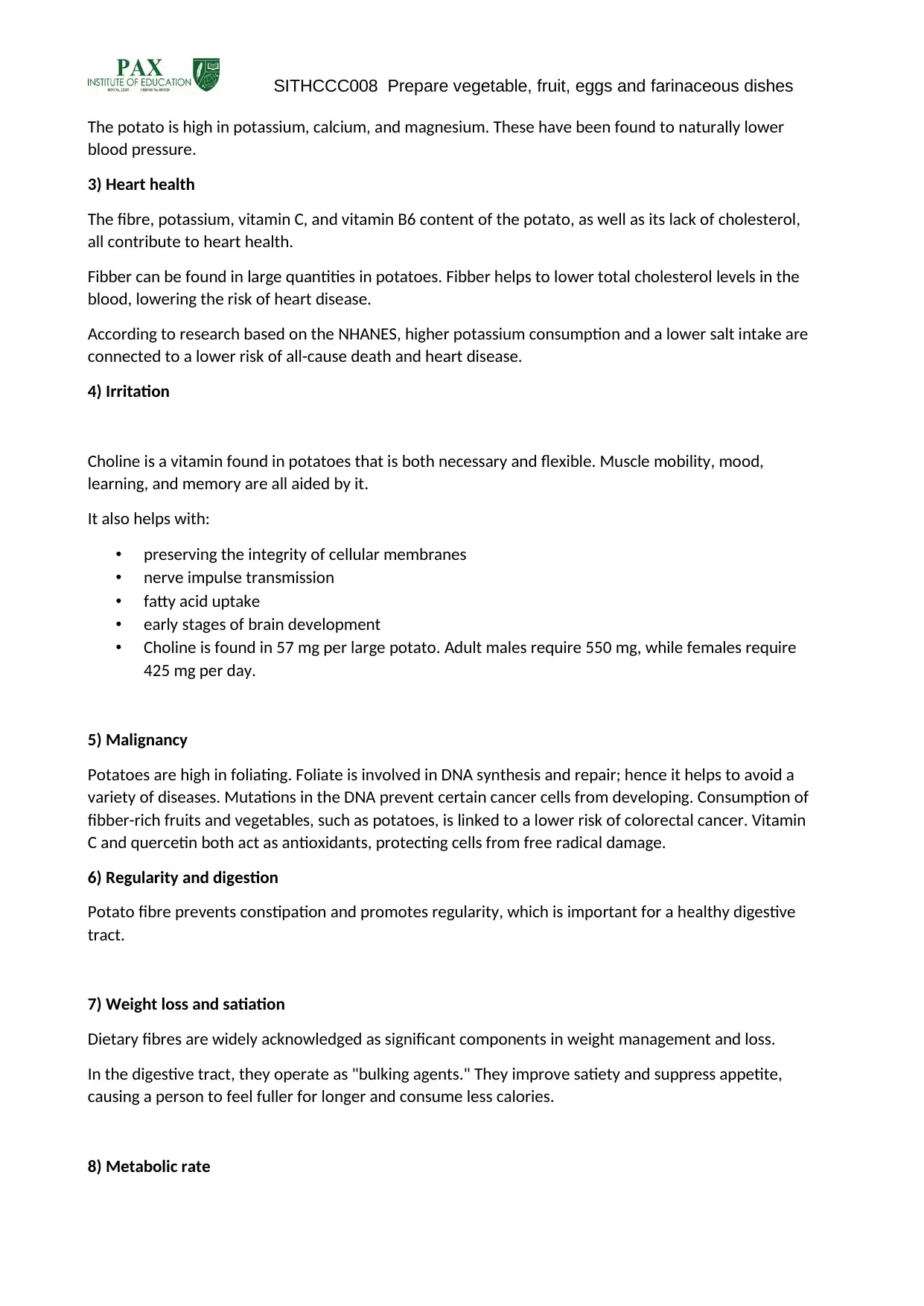
SITHCCC008 Prepare vegetable, fruit, eggs and farinaceous dishes
The potato is high in potassium, calcium, and magnesium. These have been found to naturally lower
blood pressure.
3) Heart health
The fibre, potassium, vitamin C, and vitamin B6 content of the potato, as well as its lack of cholesterol,
all contribute to heart health.
Fibber can be found in large quantities in potatoes. Fibber helps to lower total cholesterol levels in the
blood, lowering the risk of heart disease.
According to research based on the NHANES, higher potassium consumption and a lower salt intake are
connected to a lower risk of all-cause death and heart disease.
4) Irritation
Choline is a vitamin found in potatoes that is both necessary and flexible. Muscle mobility, mood,
learning, and memory are all aided by it.
It also helps with:
• preserving the integrity of cellular membranes
• nerve impulse transmission
• fatty acid uptake
• early stages of brain development
• Choline is found in 57 mg per large potato. Adult males require 550 mg, while females require
425 mg per day.
5) Malignancy
Potatoes are high in foliating. Foliate is involved in DNA synthesis and repair; hence it helps to avoid a
variety of diseases. Mutations in the DNA prevent certain cancer cells from developing. Consumption of
fibber-rich fruits and vegetables, such as potatoes, is linked to a lower risk of colorectal cancer. Vitamin
C and quercetin both act as antioxidants, protecting cells from free radical damage.
6) Regularity and digestion
Potato fibre prevents constipation and promotes regularity, which is important for a healthy digestive
tract.
7) Weight loss and satiation
Dietary fibres are widely acknowledged as significant components in weight management and loss.
In the digestive tract, they operate as "bulking agents." They improve satiety and suppress appetite,
causing a person to feel fuller for longer and consume less calories.
8) Metabolic rate
The potato is high in potassium, calcium, and magnesium. These have been found to naturally lower
blood pressure.
3) Heart health
The fibre, potassium, vitamin C, and vitamin B6 content of the potato, as well as its lack of cholesterol,
all contribute to heart health.
Fibber can be found in large quantities in potatoes. Fibber helps to lower total cholesterol levels in the
blood, lowering the risk of heart disease.
According to research based on the NHANES, higher potassium consumption and a lower salt intake are
connected to a lower risk of all-cause death and heart disease.
4) Irritation
Choline is a vitamin found in potatoes that is both necessary and flexible. Muscle mobility, mood,
learning, and memory are all aided by it.
It also helps with:
• preserving the integrity of cellular membranes
• nerve impulse transmission
• fatty acid uptake
• early stages of brain development
• Choline is found in 57 mg per large potato. Adult males require 550 mg, while females require
425 mg per day.
5) Malignancy
Potatoes are high in foliating. Foliate is involved in DNA synthesis and repair; hence it helps to avoid a
variety of diseases. Mutations in the DNA prevent certain cancer cells from developing. Consumption of
fibber-rich fruits and vegetables, such as potatoes, is linked to a lower risk of colorectal cancer. Vitamin
C and quercetin both act as antioxidants, protecting cells from free radical damage.
6) Regularity and digestion
Potato fibre prevents constipation and promotes regularity, which is important for a healthy digestive
tract.
7) Weight loss and satiation
Dietary fibres are widely acknowledged as significant components in weight management and loss.
In the digestive tract, they operate as "bulking agents." They improve satiety and suppress appetite,
causing a person to feel fuller for longer and consume less calories.
8) Metabolic rate
Paraphrase This Document
Need a fresh take? Get an instant paraphrase of this document with our AI Paraphraser
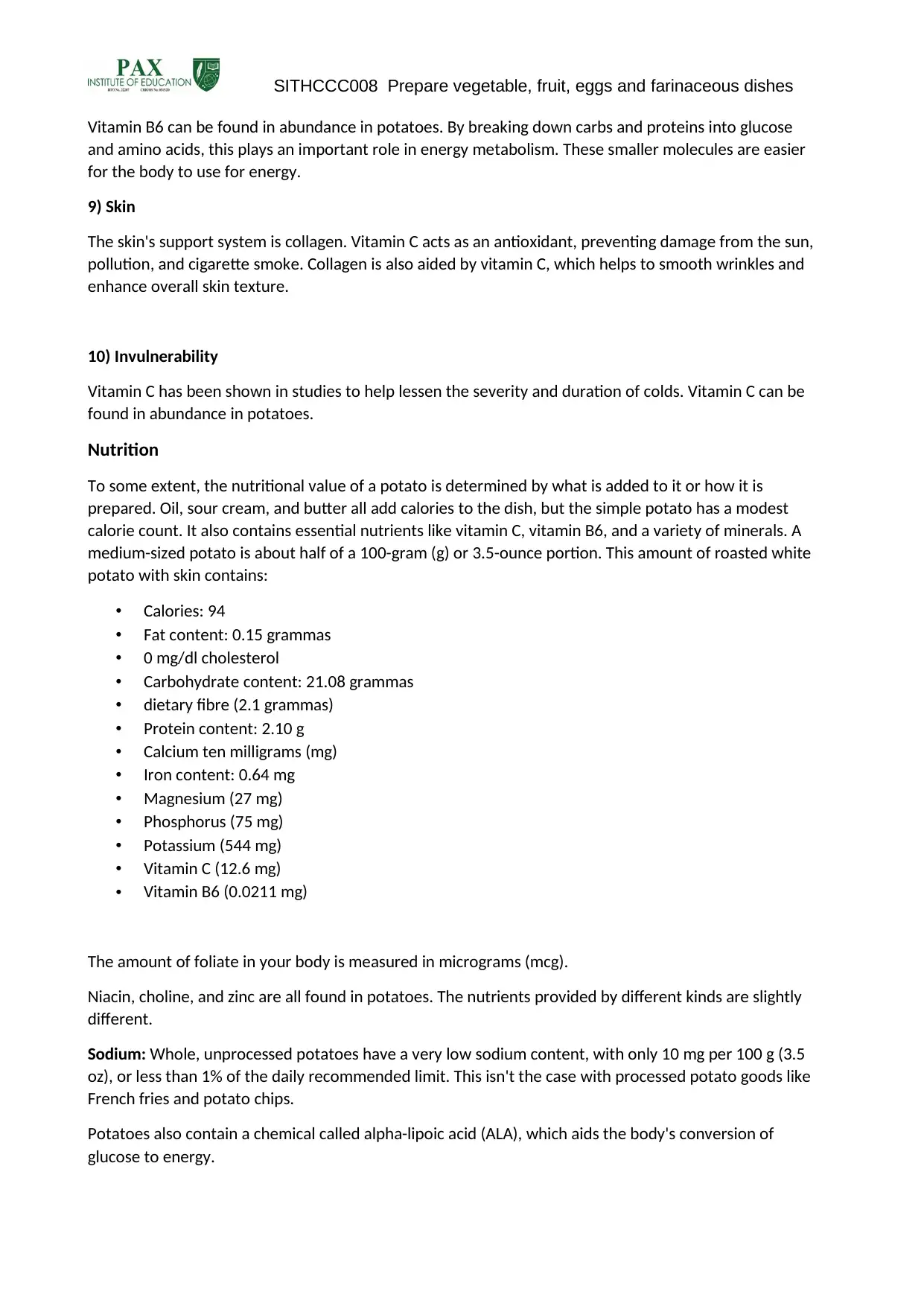
SITHCCC008 Prepare vegetable, fruit, eggs and farinaceous dishes
Vitamin B6 can be found in abundance in potatoes. By breaking down carbs and proteins into glucose
and amino acids, this plays an important role in energy metabolism. These smaller molecules are easier
for the body to use for energy.
9) Skin
The skin's support system is collagen. Vitamin C acts as an antioxidant, preventing damage from the sun,
pollution, and cigarette smoke. Collagen is also aided by vitamin C, which helps to smooth wrinkles and
enhance overall skin texture.
10) Invulnerability
Vitamin C has been shown in studies to help lessen the severity and duration of colds. Vitamin C can be
found in abundance in potatoes.
Nutrition
To some extent, the nutritional value of a potato is determined by what is added to it or how it is
prepared. Oil, sour cream, and butter all add calories to the dish, but the simple potato has a modest
calorie count. It also contains essential nutrients like vitamin C, vitamin B6, and a variety of minerals. A
medium-sized potato is about half of a 100-gram (g) or 3.5-ounce portion. This amount of roasted white
potato with skin contains:
• Calories: 94
• Fat content: 0.15 grammas
• 0 mg/dl cholesterol
• Carbohydrate content: 21.08 grammas
• dietary fibre (2.1 grammas)
• Protein content: 2.10 g
• Calcium ten milligrams (mg)
• Iron content: 0.64 mg
• Magnesium (27 mg)
• Phosphorus (75 mg)
• Potassium (544 mg)
• Vitamin C (12.6 mg)
• Vitamin B6 (0.0211 mg)
The amount of foliate in your body is measured in micrograms (mcg).
Niacin, choline, and zinc are all found in potatoes. The nutrients provided by different kinds are slightly
different.
Sodium: Whole, unprocessed potatoes have a very low sodium content, with only 10 mg per 100 g (3.5
oz), or less than 1% of the daily recommended limit. This isn't the case with processed potato goods like
French fries and potato chips.
Potatoes also contain a chemical called alpha-lipoic acid (ALA), which aids the body's conversion of
glucose to energy.
Vitamin B6 can be found in abundance in potatoes. By breaking down carbs and proteins into glucose
and amino acids, this plays an important role in energy metabolism. These smaller molecules are easier
for the body to use for energy.
9) Skin
The skin's support system is collagen. Vitamin C acts as an antioxidant, preventing damage from the sun,
pollution, and cigarette smoke. Collagen is also aided by vitamin C, which helps to smooth wrinkles and
enhance overall skin texture.
10) Invulnerability
Vitamin C has been shown in studies to help lessen the severity and duration of colds. Vitamin C can be
found in abundance in potatoes.
Nutrition
To some extent, the nutritional value of a potato is determined by what is added to it or how it is
prepared. Oil, sour cream, and butter all add calories to the dish, but the simple potato has a modest
calorie count. It also contains essential nutrients like vitamin C, vitamin B6, and a variety of minerals. A
medium-sized potato is about half of a 100-gram (g) or 3.5-ounce portion. This amount of roasted white
potato with skin contains:
• Calories: 94
• Fat content: 0.15 grammas
• 0 mg/dl cholesterol
• Carbohydrate content: 21.08 grammas
• dietary fibre (2.1 grammas)
• Protein content: 2.10 g
• Calcium ten milligrams (mg)
• Iron content: 0.64 mg
• Magnesium (27 mg)
• Phosphorus (75 mg)
• Potassium (544 mg)
• Vitamin C (12.6 mg)
• Vitamin B6 (0.0211 mg)
The amount of foliate in your body is measured in micrograms (mcg).
Niacin, choline, and zinc are all found in potatoes. The nutrients provided by different kinds are slightly
different.
Sodium: Whole, unprocessed potatoes have a very low sodium content, with only 10 mg per 100 g (3.5
oz), or less than 1% of the daily recommended limit. This isn't the case with processed potato goods like
French fries and potato chips.
Potatoes also contain a chemical called alpha-lipoic acid (ALA), which aids the body's conversion of
glucose to energy.
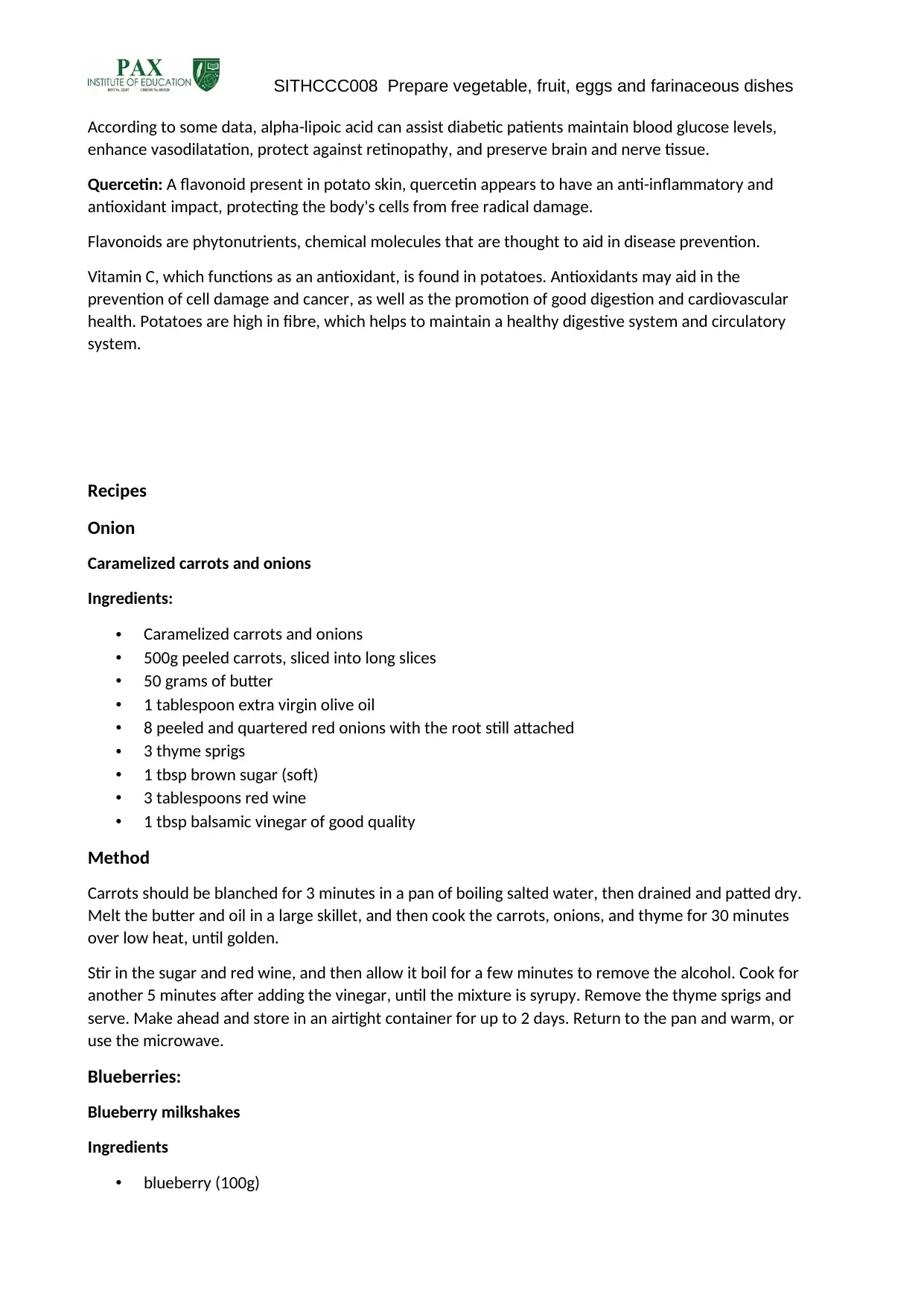
SITHCCC008 Prepare vegetable, fruit, eggs and farinaceous dishes
According to some data, alpha-lipoic acid can assist diabetic patients maintain blood glucose levels,
enhance vasodilatation, protect against retinopathy, and preserve brain and nerve tissue.
Quercetin: A flavonoid present in potato skin, quercetin appears to have an anti-inflammatory and
antioxidant impact, protecting the body's cells from free radical damage.
Flavonoids are phytonutrients, chemical molecules that are thought to aid in disease prevention.
Vitamin C, which functions as an antioxidant, is found in potatoes. Antioxidants may aid in the
prevention of cell damage and cancer, as well as the promotion of good digestion and cardiovascular
health. Potatoes are high in fibre, which helps to maintain a healthy digestive system and circulatory
system.
Recipes
Onion
Caramelized carrots and onions
Ingredients:
• Caramelized carrots and onions
• 500g peeled carrots, sliced into long slices
• 50 grams of butter
• 1 tablespoon extra virgin olive oil
• 8 peeled and quartered red onions with the root still attached
• 3 thyme sprigs
• 1 tbsp brown sugar (soft)
• 3 tablespoons red wine
• 1 tbsp balsamic vinegar of good quality
Method
Carrots should be blanched for 3 minutes in a pan of boiling salted water, then drained and patted dry.
Melt the butter and oil in a large skillet, and then cook the carrots, onions, and thyme for 30 minutes
over low heat, until golden.
Stir in the sugar and red wine, and then allow it boil for a few minutes to remove the alcohol. Cook for
another 5 minutes after adding the vinegar, until the mixture is syrupy. Remove the thyme sprigs and
serve. Make ahead and store in an airtight container for up to 2 days. Return to the pan and warm, or
use the microwave.
Blueberries:
Blueberry milkshakes
Ingredients
• blueberry (100g)
According to some data, alpha-lipoic acid can assist diabetic patients maintain blood glucose levels,
enhance vasodilatation, protect against retinopathy, and preserve brain and nerve tissue.
Quercetin: A flavonoid present in potato skin, quercetin appears to have an anti-inflammatory and
antioxidant impact, protecting the body's cells from free radical damage.
Flavonoids are phytonutrients, chemical molecules that are thought to aid in disease prevention.
Vitamin C, which functions as an antioxidant, is found in potatoes. Antioxidants may aid in the
prevention of cell damage and cancer, as well as the promotion of good digestion and cardiovascular
health. Potatoes are high in fibre, which helps to maintain a healthy digestive system and circulatory
system.
Recipes
Onion
Caramelized carrots and onions
Ingredients:
• Caramelized carrots and onions
• 500g peeled carrots, sliced into long slices
• 50 grams of butter
• 1 tablespoon extra virgin olive oil
• 8 peeled and quartered red onions with the root still attached
• 3 thyme sprigs
• 1 tbsp brown sugar (soft)
• 3 tablespoons red wine
• 1 tbsp balsamic vinegar of good quality
Method
Carrots should be blanched for 3 minutes in a pan of boiling salted water, then drained and patted dry.
Melt the butter and oil in a large skillet, and then cook the carrots, onions, and thyme for 30 minutes
over low heat, until golden.
Stir in the sugar and red wine, and then allow it boil for a few minutes to remove the alcohol. Cook for
another 5 minutes after adding the vinegar, until the mixture is syrupy. Remove the thyme sprigs and
serve. Make ahead and store in an airtight container for up to 2 days. Return to the pan and warm, or
use the microwave.
Blueberries:
Blueberry milkshakes
Ingredients
• blueberry (100g)
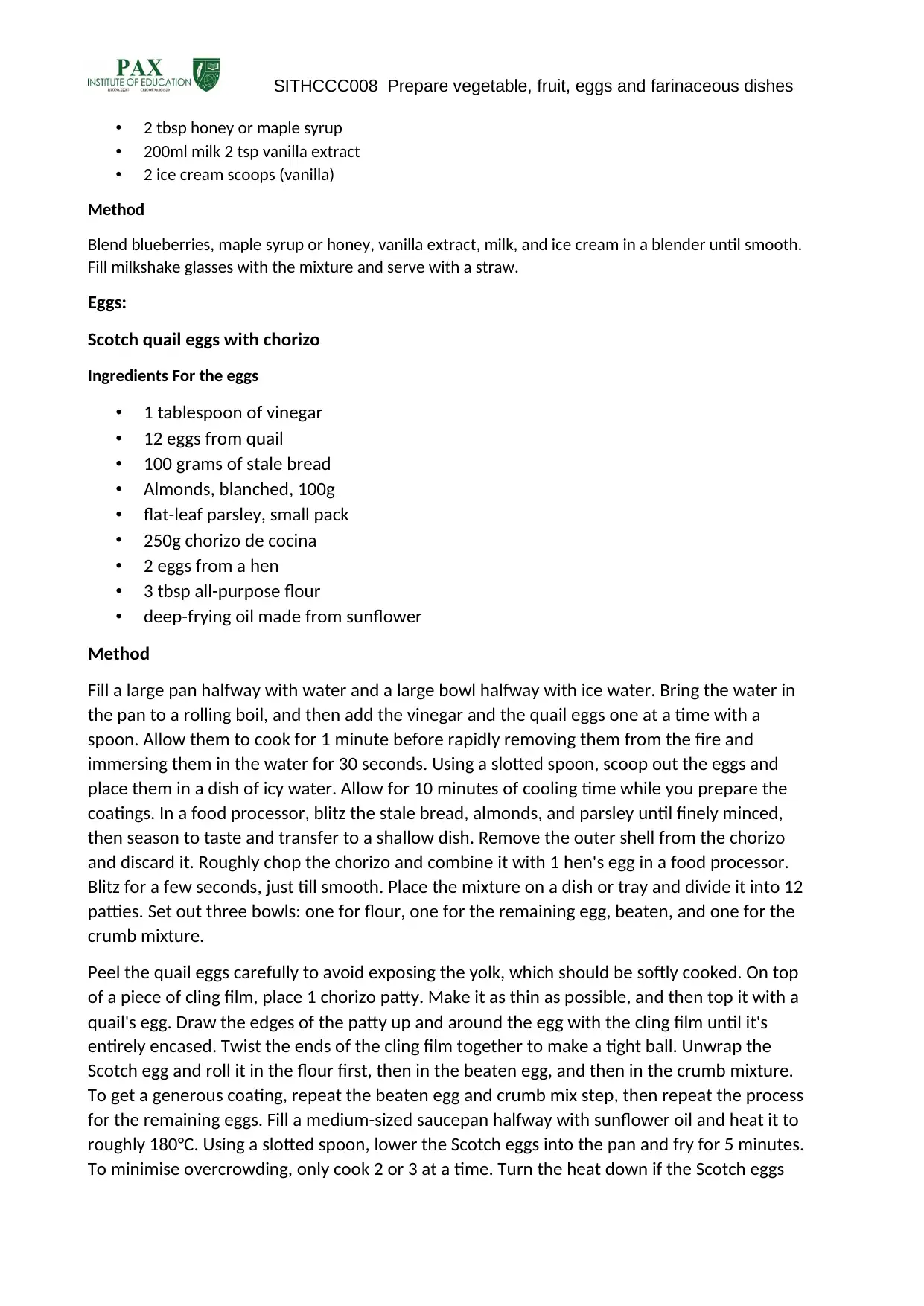
SITHCCC008 Prepare vegetable, fruit, eggs and farinaceous dishes
• 2 tbsp honey or maple syrup
• 200ml milk 2 tsp vanilla extract
• 2 ice cream scoops (vanilla)
Method
Blend blueberries, maple syrup or honey, vanilla extract, milk, and ice cream in a blender until smooth.
Fill milkshake glasses with the mixture and serve with a straw.
Eggs:
Scotch quail eggs with chorizo
Ingredients For the eggs
• 1 tablespoon of vinegar
• 12 eggs from quail
• 100 grams of stale bread
• Almonds, blanched, 100g
• flat-leaf parsley, small pack
• 250g chorizo de cocina
• 2 eggs from a hen
• 3 tbsp all-purpose flour
• deep-frying oil made from sunflower
Method
Fill a large pan halfway with water and a large bowl halfway with ice water. Bring the water in
the pan to a rolling boil, and then add the vinegar and the quail eggs one at a time with a
spoon. Allow them to cook for 1 minute before rapidly removing them from the fire and
immersing them in the water for 30 seconds. Using a slotted spoon, scoop out the eggs and
place them in a dish of icy water. Allow for 10 minutes of cooling time while you prepare the
coatings. In a food processor, blitz the stale bread, almonds, and parsley until finely minced,
then season to taste and transfer to a shallow dish. Remove the outer shell from the chorizo
and discard it. Roughly chop the chorizo and combine it with 1 hen's egg in a food processor.
Blitz for a few seconds, just till smooth. Place the mixture on a dish or tray and divide it into 12
patties. Set out three bowls: one for flour, one for the remaining egg, beaten, and one for the
crumb mixture.
Peel the quail eggs carefully to avoid exposing the yolk, which should be softly cooked. On top
of a piece of cling film, place 1 chorizo patty. Make it as thin as possible, and then top it with a
quail's egg. Draw the edges of the patty up and around the egg with the cling film until it's
entirely encased. Twist the ends of the cling film together to make a tight ball. Unwrap the
Scotch egg and roll it in the flour first, then in the beaten egg, and then in the crumb mixture.
To get a generous coating, repeat the beaten egg and crumb mix step, then repeat the process
for the remaining eggs. Fill a medium-sized saucepan halfway with sunflower oil and heat it to
roughly 180°C. Using a slotted spoon, lower the Scotch eggs into the pan and fry for 5 minutes.
To minimise overcrowding, only cook 2 or 3 at a time. Turn the heat down if the Scotch eggs
• 2 tbsp honey or maple syrup
• 200ml milk 2 tsp vanilla extract
• 2 ice cream scoops (vanilla)
Method
Blend blueberries, maple syrup or honey, vanilla extract, milk, and ice cream in a blender until smooth.
Fill milkshake glasses with the mixture and serve with a straw.
Eggs:
Scotch quail eggs with chorizo
Ingredients For the eggs
• 1 tablespoon of vinegar
• 12 eggs from quail
• 100 grams of stale bread
• Almonds, blanched, 100g
• flat-leaf parsley, small pack
• 250g chorizo de cocina
• 2 eggs from a hen
• 3 tbsp all-purpose flour
• deep-frying oil made from sunflower
Method
Fill a large pan halfway with water and a large bowl halfway with ice water. Bring the water in
the pan to a rolling boil, and then add the vinegar and the quail eggs one at a time with a
spoon. Allow them to cook for 1 minute before rapidly removing them from the fire and
immersing them in the water for 30 seconds. Using a slotted spoon, scoop out the eggs and
place them in a dish of icy water. Allow for 10 minutes of cooling time while you prepare the
coatings. In a food processor, blitz the stale bread, almonds, and parsley until finely minced,
then season to taste and transfer to a shallow dish. Remove the outer shell from the chorizo
and discard it. Roughly chop the chorizo and combine it with 1 hen's egg in a food processor.
Blitz for a few seconds, just till smooth. Place the mixture on a dish or tray and divide it into 12
patties. Set out three bowls: one for flour, one for the remaining egg, beaten, and one for the
crumb mixture.
Peel the quail eggs carefully to avoid exposing the yolk, which should be softly cooked. On top
of a piece of cling film, place 1 chorizo patty. Make it as thin as possible, and then top it with a
quail's egg. Draw the edges of the patty up and around the egg with the cling film until it's
entirely encased. Twist the ends of the cling film together to make a tight ball. Unwrap the
Scotch egg and roll it in the flour first, then in the beaten egg, and then in the crumb mixture.
To get a generous coating, repeat the beaten egg and crumb mix step, then repeat the process
for the remaining eggs. Fill a medium-sized saucepan halfway with sunflower oil and heat it to
roughly 180°C. Using a slotted spoon, lower the Scotch eggs into the pan and fry for 5 minutes.
To minimise overcrowding, only cook 2 or 3 at a time. Turn the heat down if the Scotch eggs
Secure Best Marks with AI Grader
Need help grading? Try our AI Grader for instant feedback on your assignments.
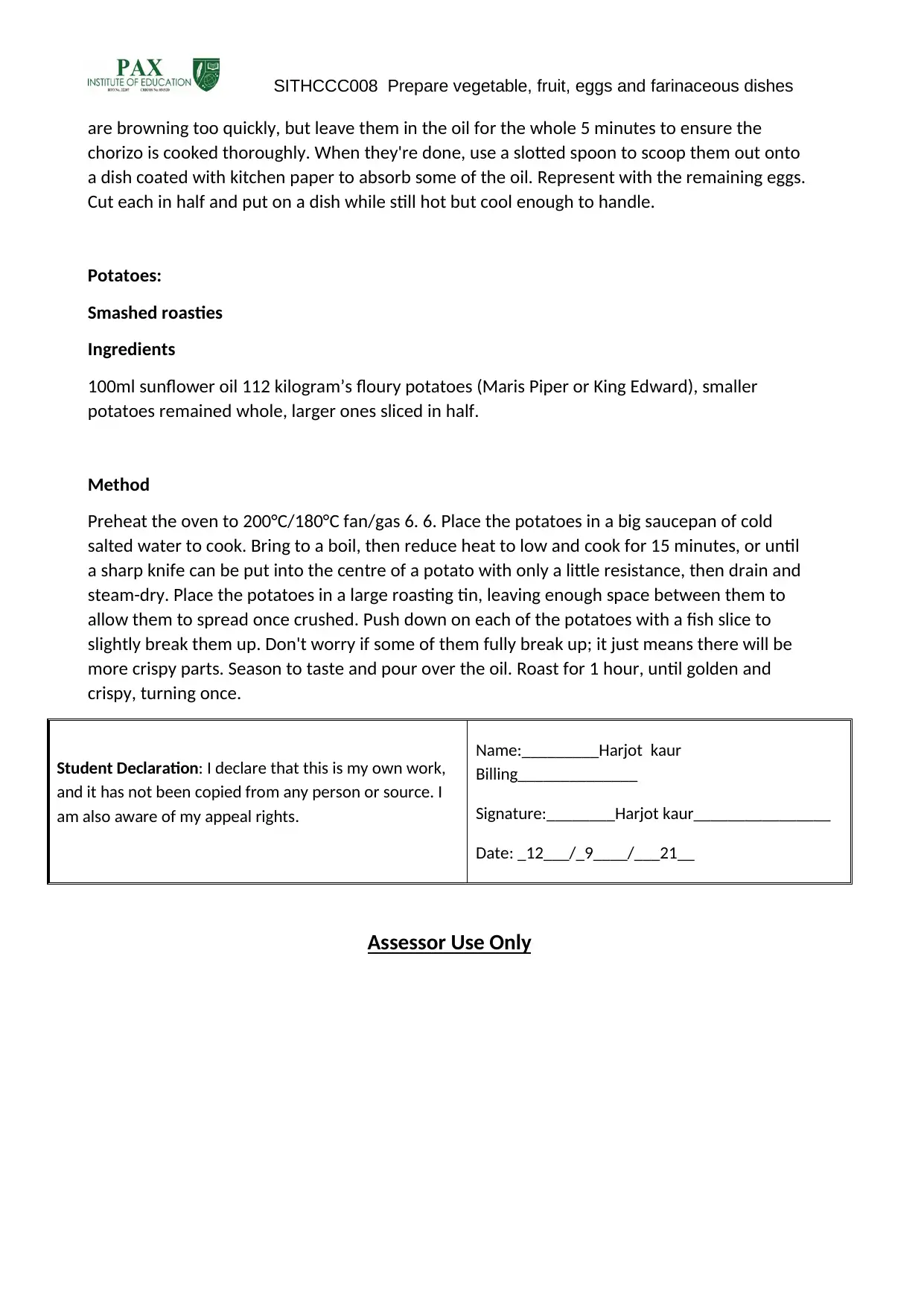
SITHCCC008 Prepare vegetable, fruit, eggs and farinaceous dishes
are browning too quickly, but leave them in the oil for the whole 5 minutes to ensure the
chorizo is cooked thoroughly. When they're done, use a slotted spoon to scoop them out onto
a dish coated with kitchen paper to absorb some of the oil. Represent with the remaining eggs.
Cut each in half and put on a dish while still hot but cool enough to handle.
Potatoes:
Smashed roasties
Ingredients
100ml sunflower oil 112 kilogram’s floury potatoes (Maris Piper or King Edward), smaller
potatoes remained whole, larger ones sliced in half.
Method
Preheat the oven to 200°C/180°C fan/gas 6. 6. Place the potatoes in a big saucepan of cold
salted water to cook. Bring to a boil, then reduce heat to low and cook for 15 minutes, or until
a sharp knife can be put into the centre of a potato with only a little resistance, then drain and
steam-dry. Place the potatoes in a large roasting tin, leaving enough space between them to
allow them to spread once crushed. Push down on each of the potatoes with a fish slice to
slightly break them up. Don't worry if some of them fully break up; it just means there will be
more crispy parts. Season to taste and pour over the oil. Roast for 1 hour, until golden and
crispy, turning once.
Student Declaration: I declare that this is my own work,
and it has not been copied from any person or source. I
am also aware of my appeal rights.
Name:_________Harjot kaur
Billing______________
Signature:________Harjot kaur________________
Date: _12___/_9____/___21__
Assessor Use Only
are browning too quickly, but leave them in the oil for the whole 5 minutes to ensure the
chorizo is cooked thoroughly. When they're done, use a slotted spoon to scoop them out onto
a dish coated with kitchen paper to absorb some of the oil. Represent with the remaining eggs.
Cut each in half and put on a dish while still hot but cool enough to handle.
Potatoes:
Smashed roasties
Ingredients
100ml sunflower oil 112 kilogram’s floury potatoes (Maris Piper or King Edward), smaller
potatoes remained whole, larger ones sliced in half.
Method
Preheat the oven to 200°C/180°C fan/gas 6. 6. Place the potatoes in a big saucepan of cold
salted water to cook. Bring to a boil, then reduce heat to low and cook for 15 minutes, or until
a sharp knife can be put into the centre of a potato with only a little resistance, then drain and
steam-dry. Place the potatoes in a large roasting tin, leaving enough space between them to
allow them to spread once crushed. Push down on each of the potatoes with a fish slice to
slightly break them up. Don't worry if some of them fully break up; it just means there will be
more crispy parts. Season to taste and pour over the oil. Roast for 1 hour, until golden and
crispy, turning once.
Student Declaration: I declare that this is my own work,
and it has not been copied from any person or source. I
am also aware of my appeal rights.
Name:_________Harjot kaur
Billing______________
Signature:________Harjot kaur________________
Date: _12___/_9____/___21__
Assessor Use Only
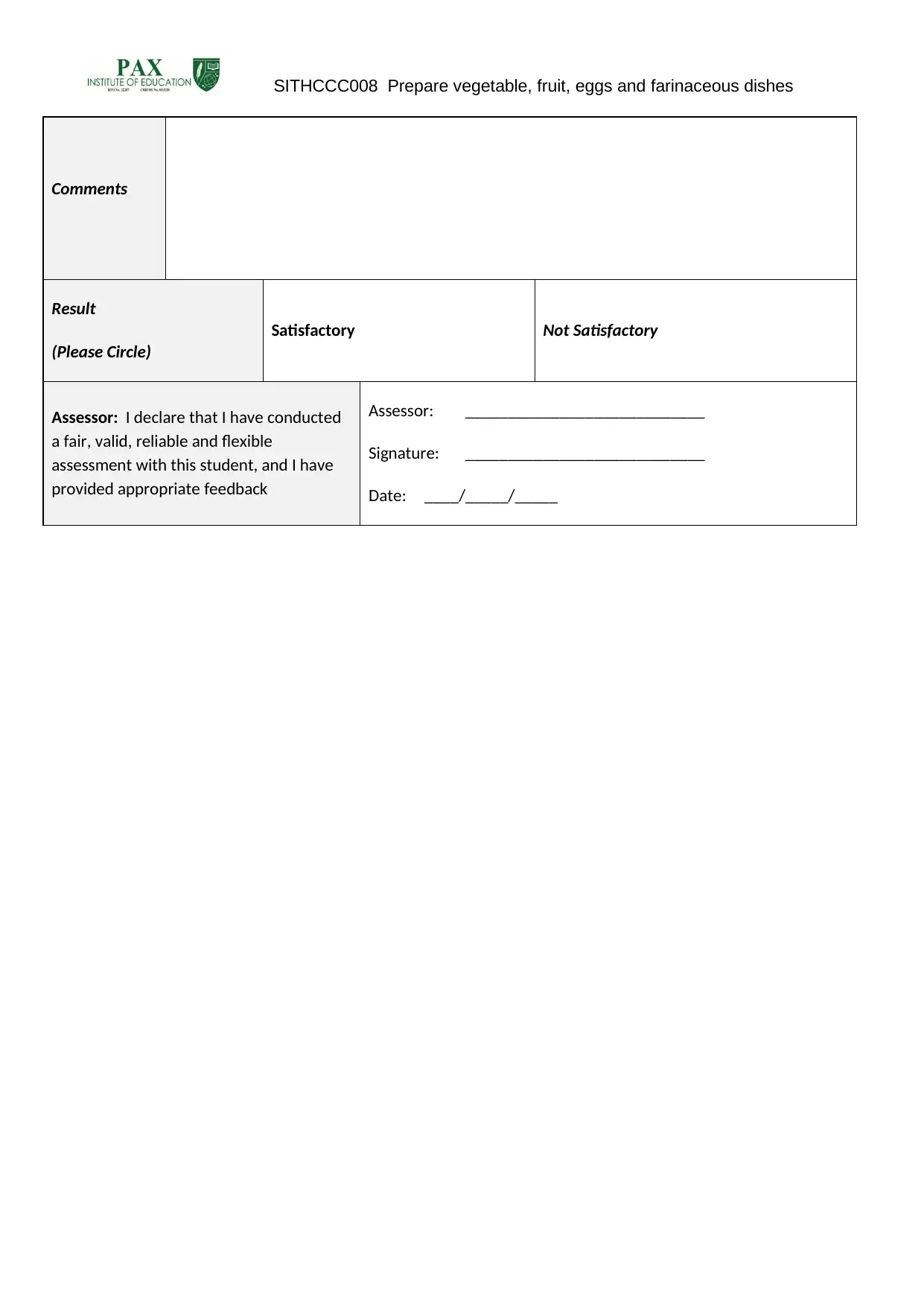
SITHCCC008 Prepare vegetable, fruit, eggs and farinaceous dishes
Comments
Result
(Please Circle)
Satisfactory Not Satisfactory
Assessor: I declare that I have conducted
a fair, valid, reliable and flexible
assessment with this student, and I have
provided appropriate feedback
Assessor: ____________________________
Signature: ____________________________
Date: ____/_____/_____
Comments
Result
(Please Circle)
Satisfactory Not Satisfactory
Assessor: I declare that I have conducted
a fair, valid, reliable and flexible
assessment with this student, and I have
provided appropriate feedback
Assessor: ____________________________
Signature: ____________________________
Date: ____/_____/_____
1 out of 18
Your All-in-One AI-Powered Toolkit for Academic Success.
+13062052269
info@desklib.com
Available 24*7 on WhatsApp / Email
![[object Object]](/_next/static/media/star-bottom.7253800d.svg)
Unlock your academic potential
© 2024 | Zucol Services PVT LTD | All rights reserved.